
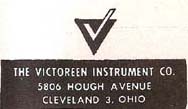
Victoreen Instrument Company
Victoreen Instrument Company started in 1928 by John Austin Victoreen, a self-taught engineer, as a group of x-ray dosimeter manufactures. He developed several instruments in the 1930’s but he commented “ no one wanted what he made” so he just put them on the shelf. These early instruments resulted in the early version of the Model 241.


Victoreen Logos 1947

Victoreen Logo 1948

Victoreen Logo 1950



Victoreen Logos 1952

Victoreen Logo 1953

Victoreen Logo 1954

Victoreen Logo 1955

Victoreen Logo 1956

Victoreen Logo 1956

Victoreen Letterhead 1955
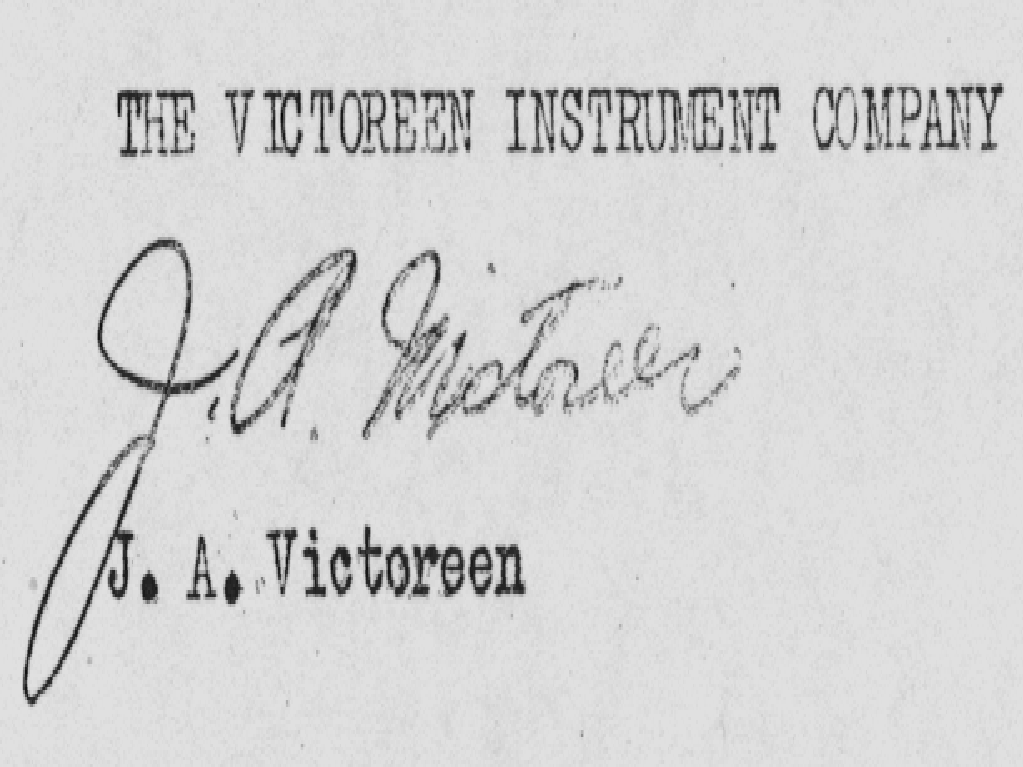
J.A. Victoreen Signature 1938
He later received an honorary doctorate in science. Until 1946, they were the only makers of nuclear instruments. In 1937, a market for nuclear instruments began to develop at the University of Chicago, Met Lab and the Critical Pile-1 (CP-1). Victoreen only had to go to his shelf of previously developed instruments and they met the need. He also developed a few special instruments for the University of Chicago, home of the first nuclear pile, CP-1. Critical to the instrument work was the development of high resistance resistors with magnitudes of 1014 to 1015 Ohms. These resistors required a technique development to put graphite on glass. Dr. Victoreen has noted that the code names were classified but the designs were not since many had been developed before the Manhattan Project. The contract between Victoreen and the Manhattan Project was secret, however, it should be noted that Victoreen made significant contributions to the Manhattan Projects success.
Victoreen is credited with building several condenser-type ionization chamber instruments in 1927 which were stored in the laboratory due to lack of need. The chamber used a carbon wall and aluminum electrode and was 1 cm3 chamber charged with a friction wheel. Glasser and Seitz made an experimental condenser-type ionization chamber with a removable chamber that could be separated from the electrometer. Glasser turned to Jack Victoreen in 1928 to market the first commercial instrument know as the Condenser R-Meter. It was an ionization meter connected to an electrometer. It soon became the industry standard. Victoreen provide 95% of the instrumentation for the South Pacific atomic bomb tests and became known as the “First Nuclear Company”. These would later become the first commercial U.S. ionization chambers developed by Victoreen in 1930. The first units were friction charged with a battery powered light for the meter. It was later known as the Victoreen R-meter.
Around this time, there was also a commercial Solomon’s Ionometer, designed by Iser Solomon, a French radiologist. It was also at this time in 1928, that Geiger and Mueller published an announcement of the developed of a device for measuring radiation. Another condenser ionization chamber was developed by William Duane. Glasser and Fricke of the Mayo clinic also developed a unit in the 1920’s. In 1929, Lauriston Taylor at the National Bureau of Standards developed the first portable survey meter incorporating interchangeable chambers for various radiation ranges. Another early instruments was developed by R.S. Landauer, Sr. of the Standard X-Ray Company of Chicago and called the Roentgenometer, which was connected by a shielded metal cable to the meter readout. Landauer was a medical physicist at Chicago’s Cook County Hospital. It was designed for measuring x-ray tube output.
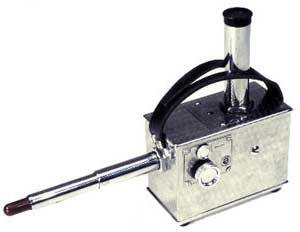
Victoreen Condenser-R 1928

Victoreen Condenser R-Meter 1930's
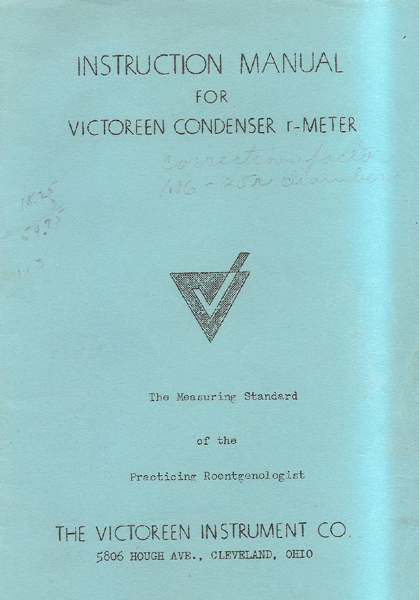
Victoreen Condenser r-Meter 1943 Manual
These early precursors were later known as the Victoreen R-meter. Victoreen has been quoted as stating that “no one wanted what I made”. They initially manufactured ion chambers which led to the production of other special components like Geiger tubes. Victoreen’s early contract to build instruments was a secret government contract not fully revealing the contributions to the development of the first atomic bomb. After the end of WWII, other contracts were let which opened commercial competition. Victoreen was the major supplier of instruments for the first atomic tests in the Marshall Islands in 1946 for the Able, Baker and Charlie tests. The Charlie test required instrumentation underwater with recording at the surface.
Victoreen Instruments was located at 3800 Perkins Avenue in Cleveland, Ohio in 1949. They later moved to 5806 Hough Avenue and produced a wide range of Geiger counters and ionization chambers beginning in the mid 1930’s for use in laboratory, military and prospecting applications. Another 1930’s instrument was the Integron, an electronic integrating ionization chamber. It was improved and modified to evolve as the Radocon in 1935. In 1940, a pocket ionization chamber, a modified R-meter chamber, was developed called the Minometer. Victoreen introduced the Iometer in 1937 for measuring x-ray beams. In 1949 they offered four models with several modifications. It advertised that it was the “World’s First Nuclear Company”.
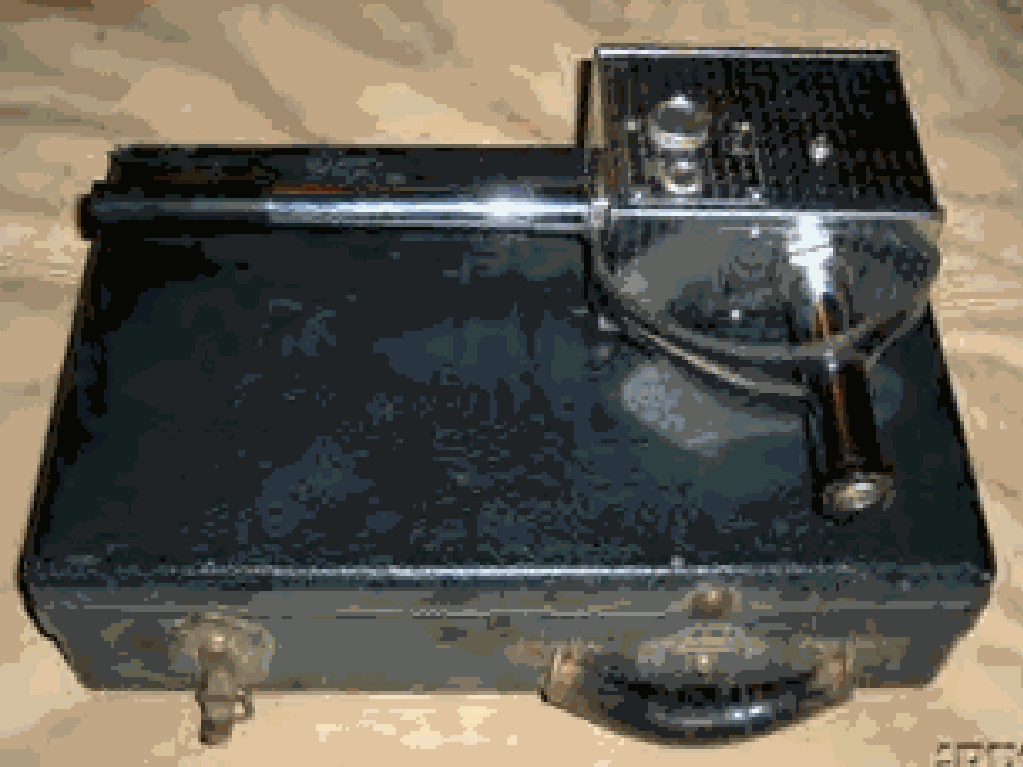
Victoreen Condenser R-Meter 1937
The Model 70 was a portable xray-gamma integrated air ionization meter introduced in 1948. It was called the “Condenser R Meter”. Chambers were available with size from 0.25, 10, 25, 100, 250, 1000, and 2500 R. The chambers were also detachable for remote detection. The chambers were made of bakelite or nylon. It used two 1.5 volt penlite cell batteries. The 250 R nylon chamber was used for soft radiation.
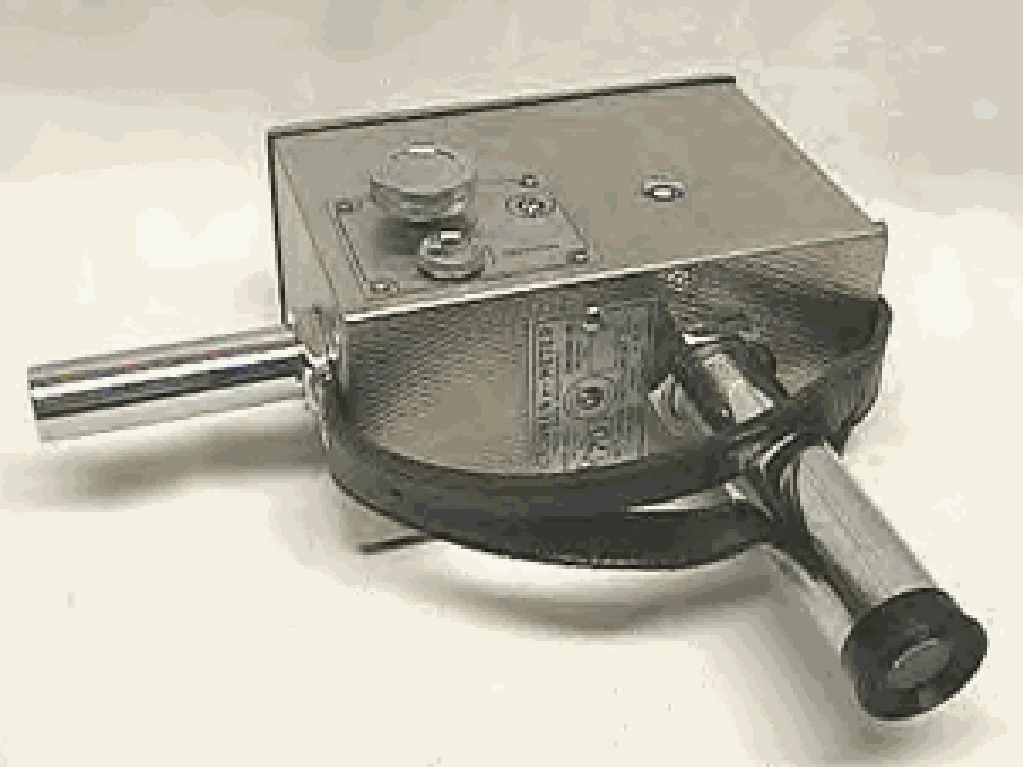
Victoreen Model 70 1948
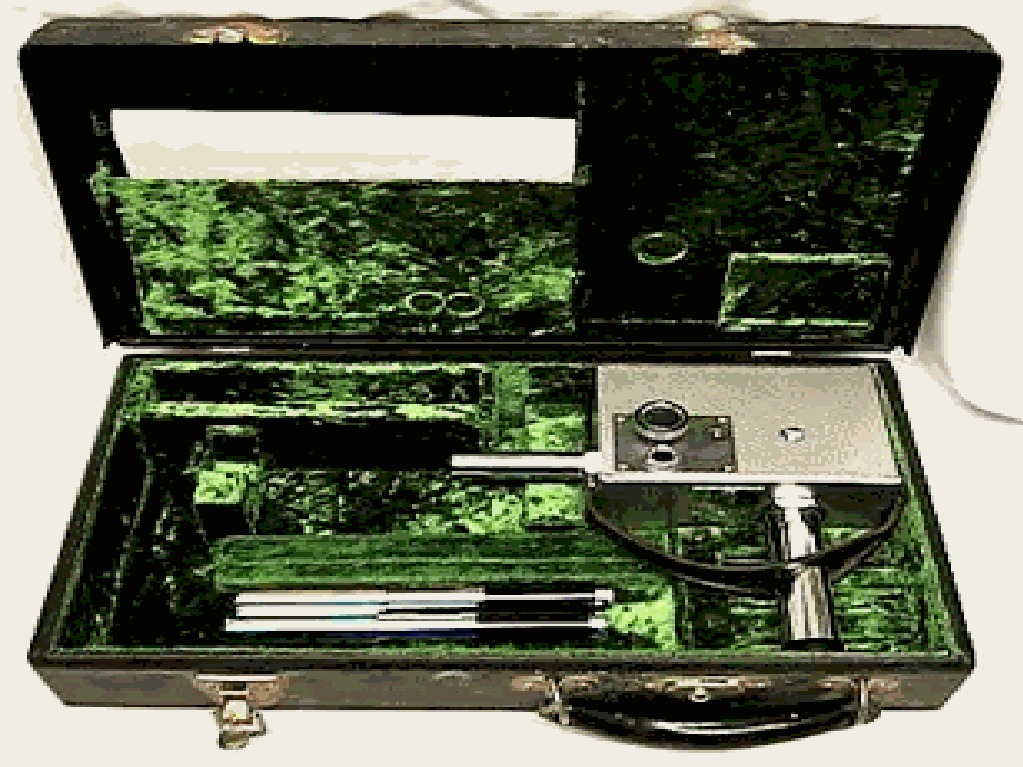
Victoreen Model 70 Kit 1948
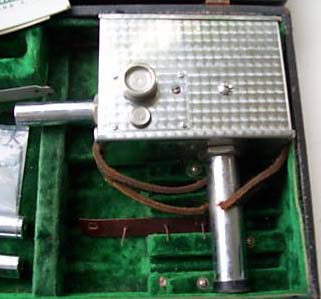
Victoreen Model 70 1950
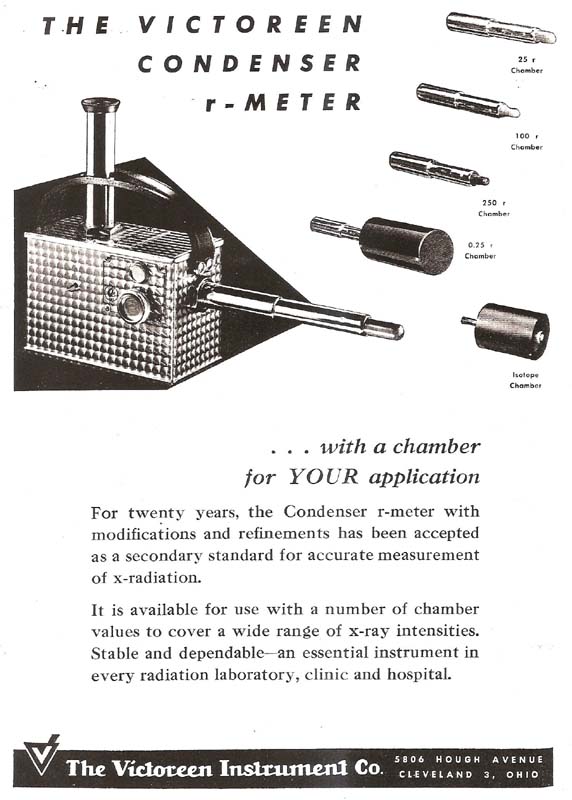
Victoreen Condenser r-Meter Ad 1952
The portable Model 263 “Doc” was introduced in 1939 or 1940. It is believed to have dated back the early 1940’s and may be the second survey instrument developed by Victoreen. It appears to be the earliest commercial instrument of its type. It was developed by Donald Collins, a staff officer in the Manhattan Project and later worked as technical director for Victoreen and then the Landsverk Electrometer Company, and Bob Smith. It was originally code named “Doc” as part of the Manhattan Project prior to WWII. It was developed into a “little black suitcase”. The unit had a self-contained GM tube for beta and gamma detection. The Geiger tube was mounted externally and attached via a clip. It had 3 ranges and calibrated with radium. It was described as "an instrument with a distinctive background of service". The Model 241 was introduced in the late 1930’s. It was a portable beta gamma air ionization rate meter. It weighs 12 lbs. It measured 15” x 11” x 3.5” and is housed in a black leather case. It was sensitive to 20 mR/h. The chamber is bakelite impregnated cardboard and has a volume of 0.6 liters. It was battery powered. The Model 241 is thought to be the one of the earliest commercial survey meters dating back to the last 1930’s. This was the first instrument to use a multi-vibrator that eliminated amplifier zero drift.
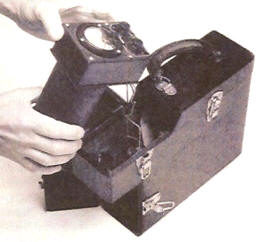
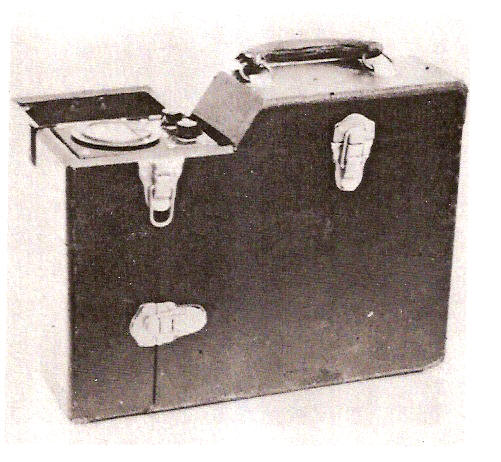
Victoreen Ionization Chamber Survey Meter 1942
The Condenser-R Meter was developed in 195x. The unit had a charger reader and an exchangeable condenser ion chamber. The chambers are available for 6-35 keV, 30-400 keV, and 400-1300 keV. The unit is 8” long x 3” wide x 8.5” high and weighs 10 lbs. It was very useful for rapid determination of x-ray dose in roentgens.
Accounts by E. Trout indicate that together with John Victoreen and George Bell, the first commercial survey meter was developed in 1942. It contained one 45 volt battery and an ionization chamber underneath the front cover. The chamber was made of a mailing tube that was “dagged”, i.e. covered with a conducting material. The meter read in milliroentgens per minute. Victoreen required electrometers and high meg resistors which were provided by Art Stokes and Fred Reuter, later of the Reuter-Stokes company.
The Model 196 was offered in 1944. It was a single range instrument which could be changed.
Need photo
Victoreen Model 196 1944
The Victoreen portable Model 247 was an ionization chamber model that superceded the Model 263 and was designed to be more rugged for military use. It was a survey meter with a 56 cubic inches air ionization chamber and was introduced commercially in 1945 and dates back to mid-1943. During World War II, Operation Peppermint was the US military response to radioactive materials being used against US forces invading Europe at Normandy beaches. Fortunately radioactive materials were not used during the invasion.
The unit provided stable operation and rugged construction, but was only sensitive to gammas. It has four ranges of sensitivity from 2.5-2500 mR/h. The Model X-247 can measure up to 50 R per day. The case is watertight and hermetically sealed. The wall of the chamber is typically made of a material that has the same absorption characteristics as air, namely carbon. A unique eccentric range switch is color coded to give visual indications of the range that the meter is set. The original Model 247 was rectangular box shape 12” long x 9” wide x 10” high and weighed 14 lbs. (1) Pictures used with permission of the Stafford Warren Collection at UCLA Charles E. Young Research Library, Department of Special Collections).
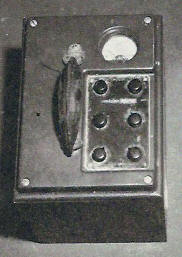
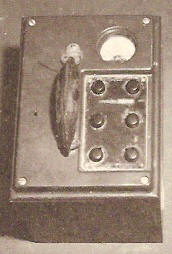
Victoreen Model X-247 1945
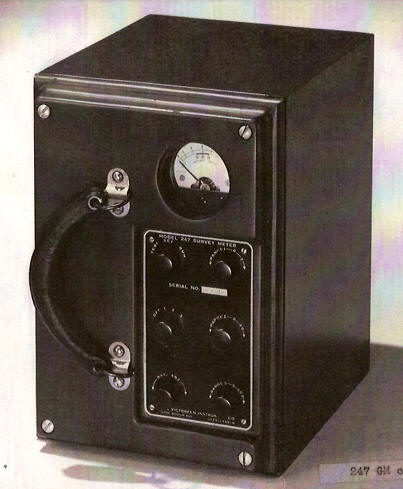
Stafford Warren Collection1 Victoreen Model 247 1945
The Model 247, 247A (IM-3/PD) and the 247A Special were evaluated in 1948 as part of Operation Sandstone. The Model 247A and 247A Special each had four decade ranges from 2.5-2,500 mR/h and 25-25,000 mR/h, respectively, for x-ray and gamma radiation. It was noted in 1948, that the Model 247 was obsolete and sent to the tests as an emergency measure, and were not used in the tests. The units were hermetically sealed and the case is watertight. The unit came in a baked grey enamel finish. Twenty-eight Model 247A units and ten of the Model 247A Special were evaluated in 1948. It was determined that the instruments were too heavy for field use, the knobs difficult to operate with gloves and the case was too narrow and unstable for field operations. The Model 247A and 247A Special sold for $250 in 1948.
In 1948, it was reported in the Chemical Corps School Radiological Defense Officers Course, that because alpha detection required a thin window, it was almost impossible to produce a field instrument to detect alphas.
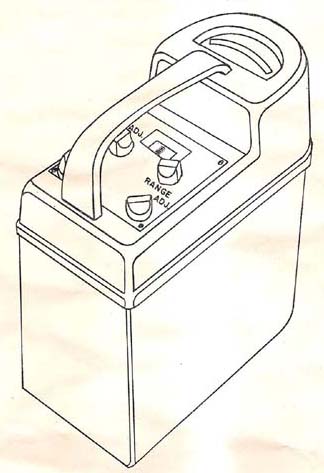
Victoreen Model X-247 1948
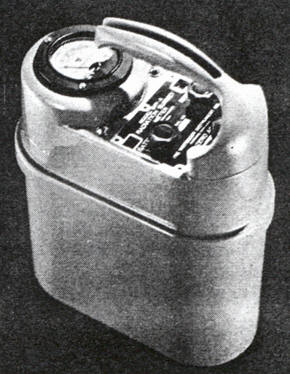
Victoreen Model 247A 1948

Victoreen Model 247A Ad 1947
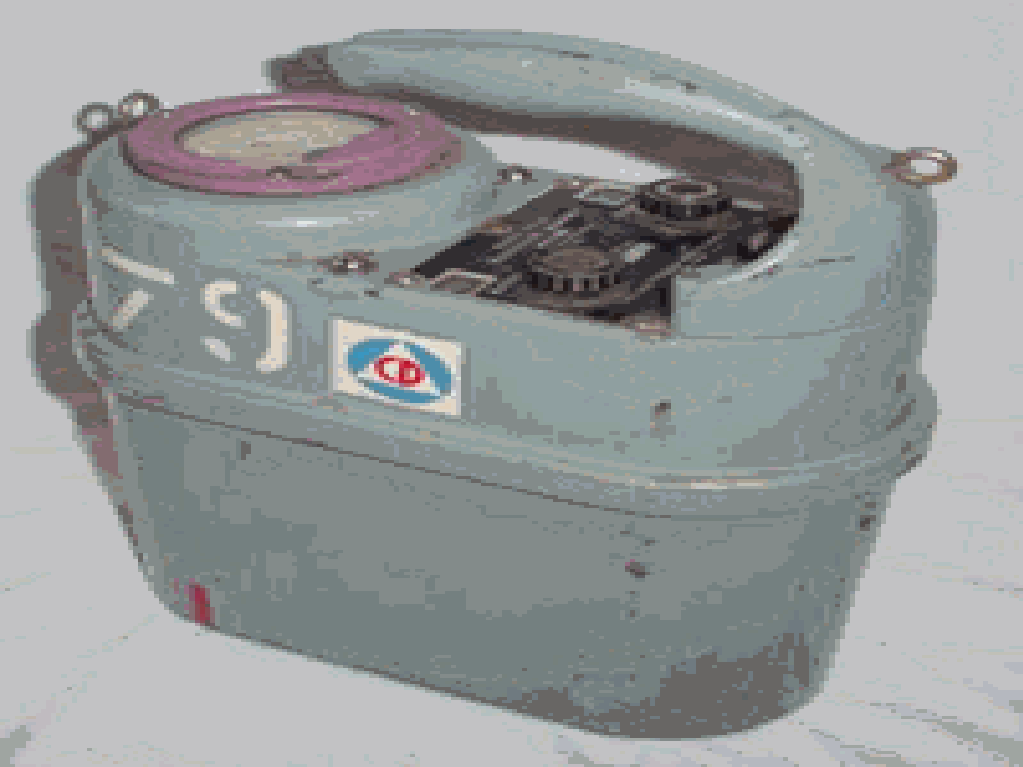

Victoreen Model 247A 1947
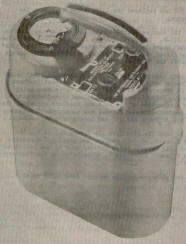
Victoreen Model 247A 1950
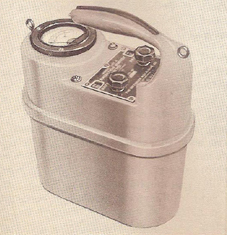
Victoreen Model 247A 1951
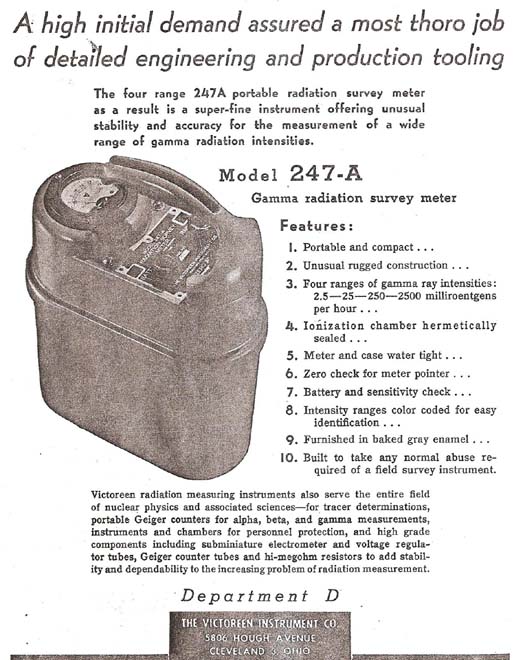
Victoreen Model 247-A Ads 1947

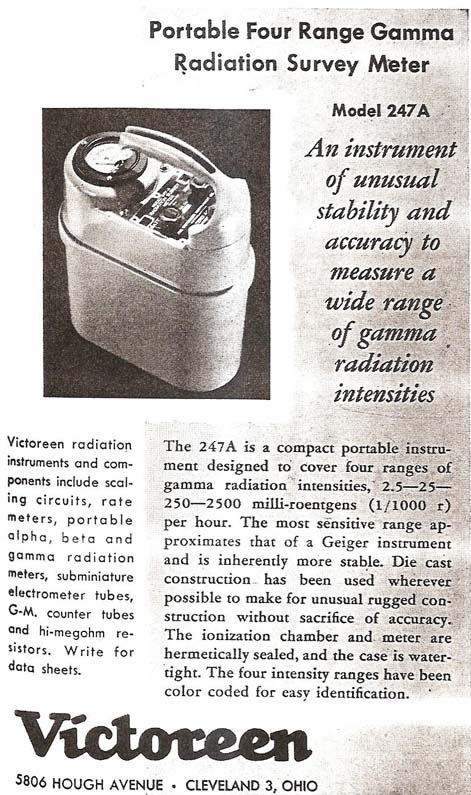
Victoreen Ads for Model 247A 1948
The Model 247A was an upgraded portable air ionization gamma rate meter. The Model 247A was introduced in 1947 as a portable ionization chamber and is claimed to combine stable operation with rugged construction. It was calibrated with two x-ray beams and gamma rays from radium. It had four-decade ranges from 2.5 to 2500 mR/h which are color coded for easy identification. The unit was approximately 6” x 10.5” x 13” and weighed 12.8 lbs. The most sensitive range approximates that of a Geiger instrument and is inherently more stable. The counter contained dry air at atmospheric pressure. The case is watertight. The ionization chamber are hermetically sealed in polyethylene and is 4” diameter x 4.5”. It used 22.5 and 45V batteries. The unit was 13” high x 10-3/8” long x 5-3/8” wide and weighed 12.6 lbs. The finish was baked enamel, navy gray. The Model 247B, also offered in 1948, had a gamma range from 25 mR, 250 mR, 2500 mR/h and 25,000 mR/h. The unit had a military designation of IM-3/PD.
The low Intensity Model 247C had a range from 2.5, 25, 250, and 2500 mR/h and the High Intensity Model 247D had ranges from 50, 500, 5000, and 50,000 mR/h. Both units had a removable front cover to expose the ion chamber to permit the measurement of x-rays. The Model 247-H had a range a four decade range from 25 to 25,000 mR/h.
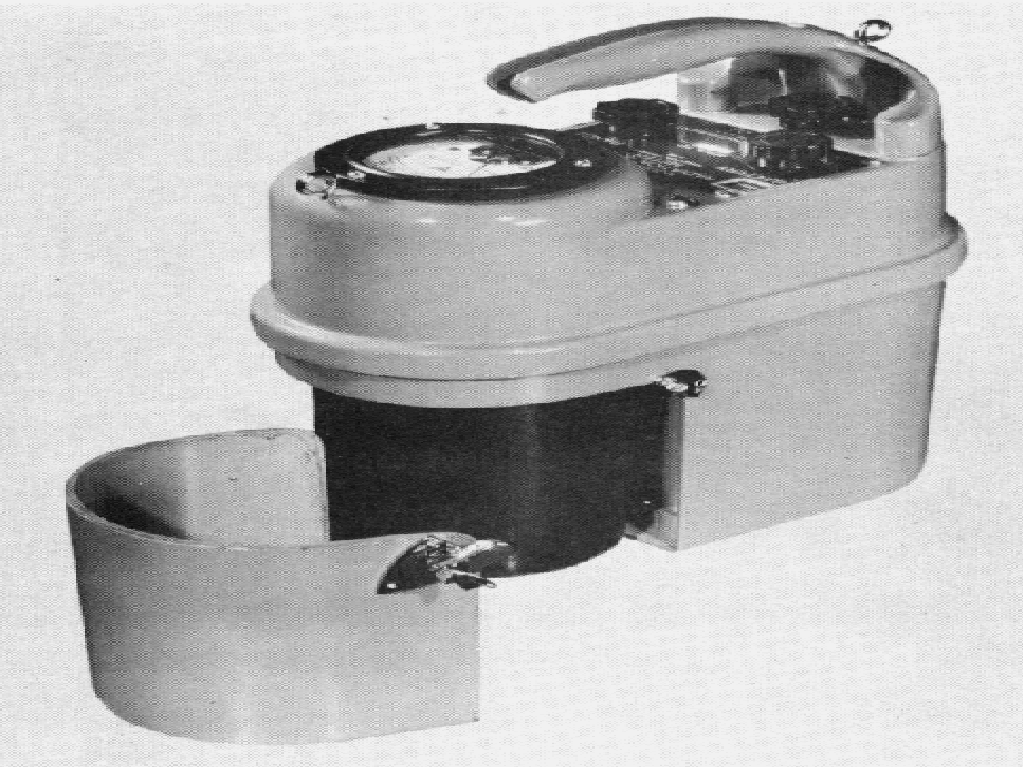
Victoreen Model 247B and 247D 1950
The Victoreen Model X-263 (AN/PDR-6) dates back to about 1944. It was originally the Make 1, Model 31A survey meter. It had three ranges from 0.2, 2 and 20 mR/h. Above this range and the unit will swing off scale and audible sound will change from clicks to a steady buzz. At this point, the unit will be “paralysed” and no sound heard. Later in Jun 1945 became the Model 263. The unit was a compact, self-contained instrument with a fixed internal, rubber-mounted GM tube for beta gamma detection. It operates on 300 volt battery. It was 9” long x 2.75” wide x 6.25” high. It was calibrated to measure directly in mR/h. The X-263 was a beta gamma radiation meter. The meter is divided into tenths and the selector switch has three range settings of x1, x5 and x20 and a “heat” setting. It had a jack for headphones. The unit weighs between 2 and 4 pounds.
The unit was used by Col. Stafford Warren who was the medical direction for the Manhattan Project. He was also in charge of radiation safety at the Trinity Test in 1945. Performance tests in March 1946 show that the unit was tested in aircraft to 30,000 feet at Wright Field, Ohio by flight surgeons of the US Navy. The old GM Model X-263 was not reliable at the Crossroads Tests. The unit had been designed in a hurry to meet new requirements not available with the larger Model 263 series. It was described as “adequate on the desk of a meticulous old lady in an air conditioned laboratory, but not useful in boats.”
The Operations Crossroads series of nuclear tests in the Pacific required new instrumentation. The Pacific test, conducted in 1946-1947, benefited the Victoreen company which provided most of the survey meter instrumentation. The tests were conducted under the auspices of Col. Stafford L. Warren, Chief Radiological Safety Officer. At this time, the Navy encountered contaminated ships. Due to the lack of radiation instruments in the Army inventory, the Bureau of Ships began a program to develop radiation monitoring instruments. During this time, the Dept of the Navy turned to big business to address its needs. The AEC, with its growing radioisotope program turned to smaller companies for assistance. In 1949, the US military began to place significant orders for radiation measuring instruments. In 1946, yearly sales of instruments was $800,000. In 1949, it was estimated to be $4,500,000. (1) Picture used with permission of the Stafford Warren Collection.

Victoreen Model X-263 1946
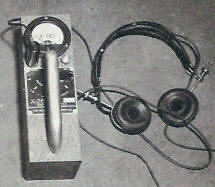

Victoreen Model X-263 1946
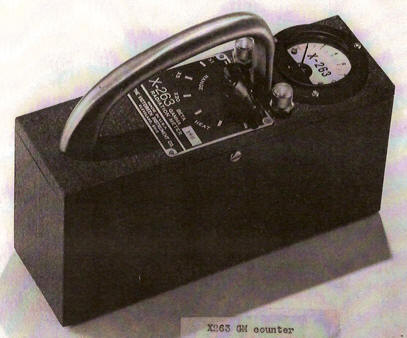
Stafford Warren Collection1 Victoreen Model X-263 1946
The Model 262 was available in 1947. It was a a Roentgen calibrated instrument used to measure scattered radiation in the vicinity of x-ray or gamma ray equipment. It has a top reading of 2 mR per minute. It was developed to spot check installations for scattered radiation to determine additional protection requirements.
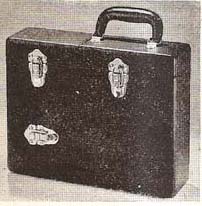
Victoreen Model 262 1947

Victoreen Ad for Model 262 and Model 263 1947
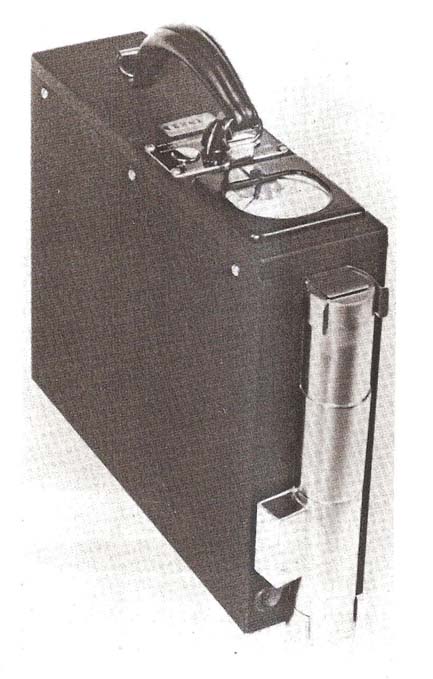
Victoreen Model 263 1947
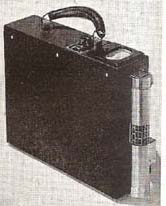
Victoreen Model 263 1947
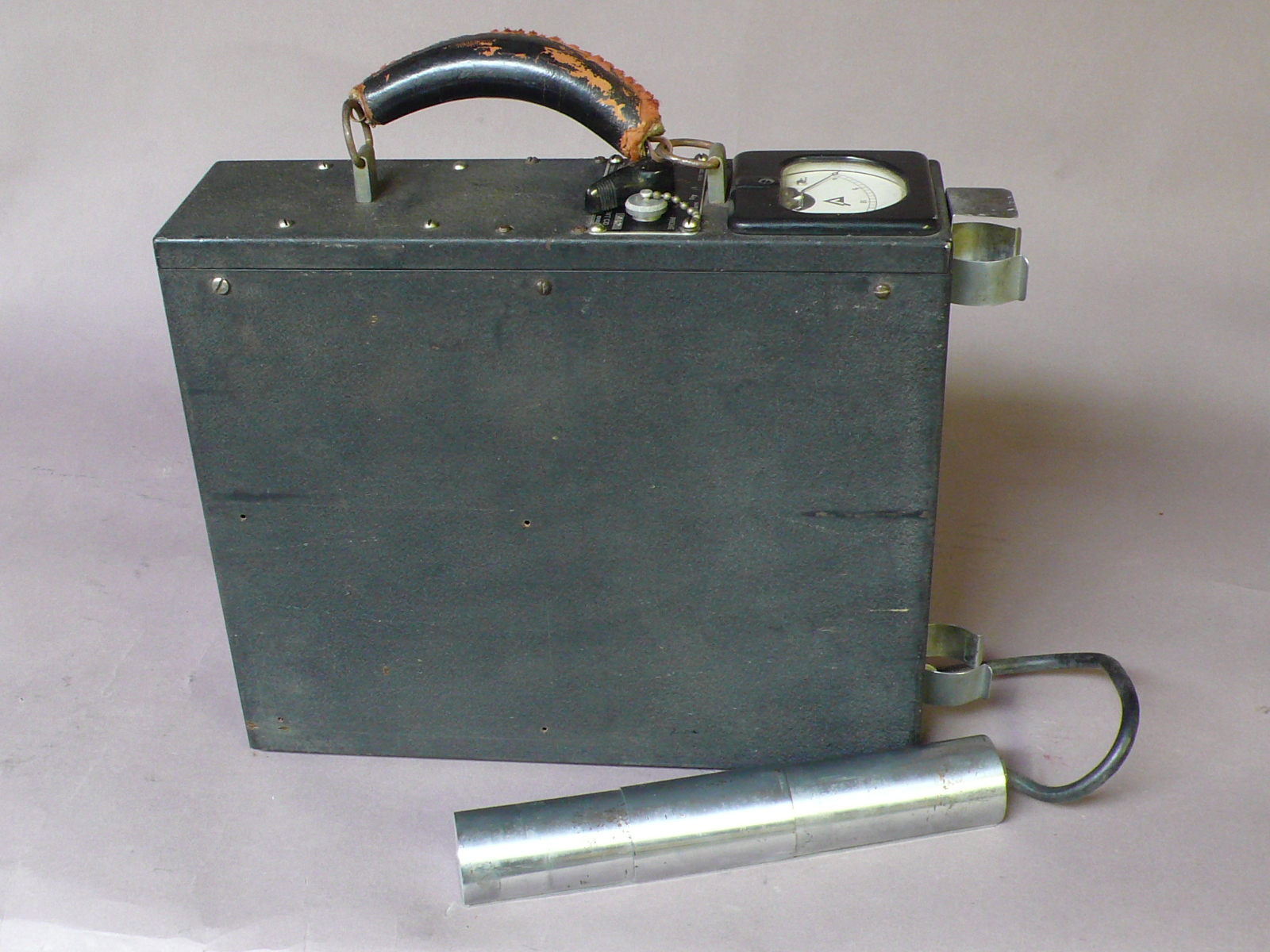
Victoreen Model 263 1940's
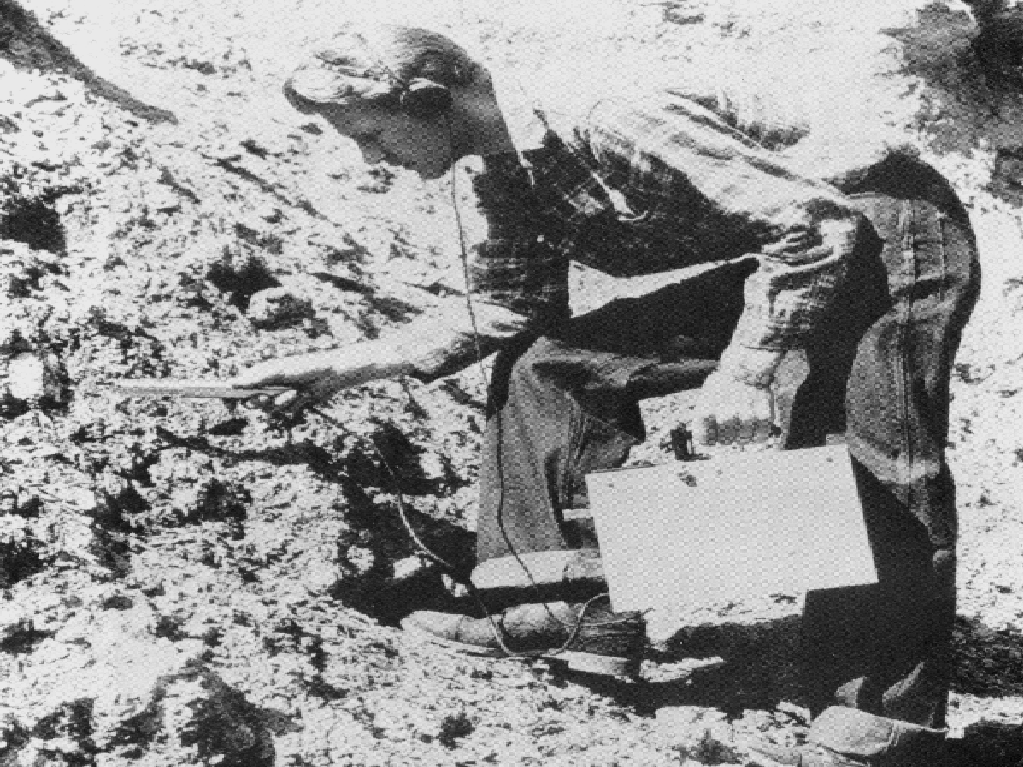
H.R. Hanson of Victoreen Instrument Co. checking portable survey meter, a Model 263 Doc 1945, from Health Physics: A Backward Glance by R. Kathren and P. Ziemer, 1980.
During the Manhattan Project survey meters were given code names as part of the overall secrecy. Several of the code names were believed to be named after the seven dwarves in Snow White. It was used at Oak Ridge in 1949. It has a thin walled glass GM tube which is filled with an 90% argon-10% alcohol mixture. It is designed to detect individual ionizing particles. The unit has three decade ranges from 0.2 to 20 mR/h as measured with radium. It used one 1.5V flashlight cell for the filament, a miniature 67.5V cell for the plate supply, and one special 960V battery for the field voltage of the Geiger tube. The tube is mounted externally in a holder and can be removed and pointed in any direction. The unit comes with headphones.
There were several special applications for these units. A deep water probe could be attached to a waterproof cable and lowered to various depths. A meter will determine the length of the cable extended. The Geiger tube could also be attached to a Sonobuoy, which when pulses are detected, it keys a radio transmitter. And lastly, the Telemeter, which is a remote meter connected to a radio receiver and measures readings sent to it by a radio.
The Model 263 was offered in 1948 as a production model of the X-263. The GM tube is located inside a probe which has a beta window. It had a meter and headphone for indications. (1) Picture used with permission of the Stafford Warren Collection.

Victoreen Model 263 1948
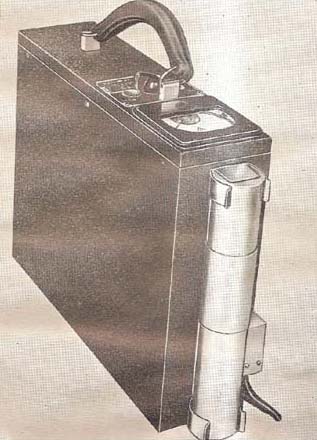
Victoreen Model 263 1948
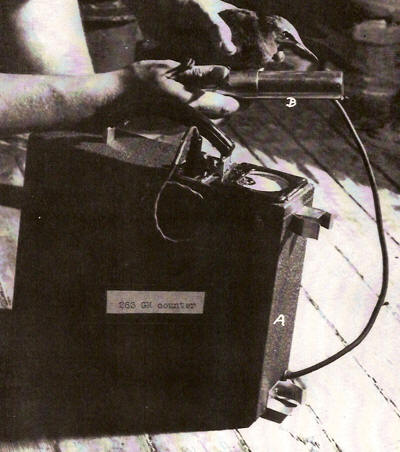
Stafford Warren Collection1 Victoreen Model 263 1948
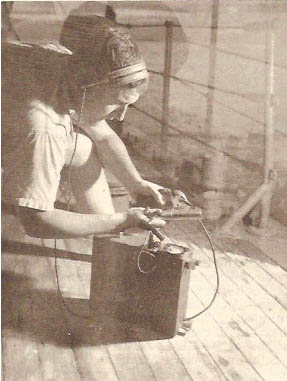
Victoreen Model 263 1940's
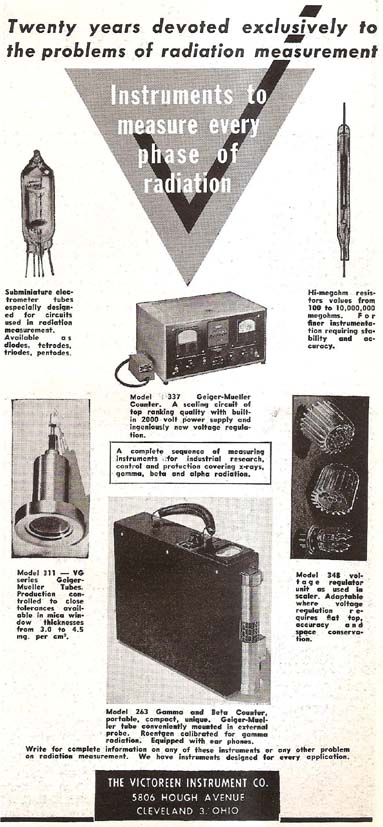
Victoreen Ad Model 263 1947
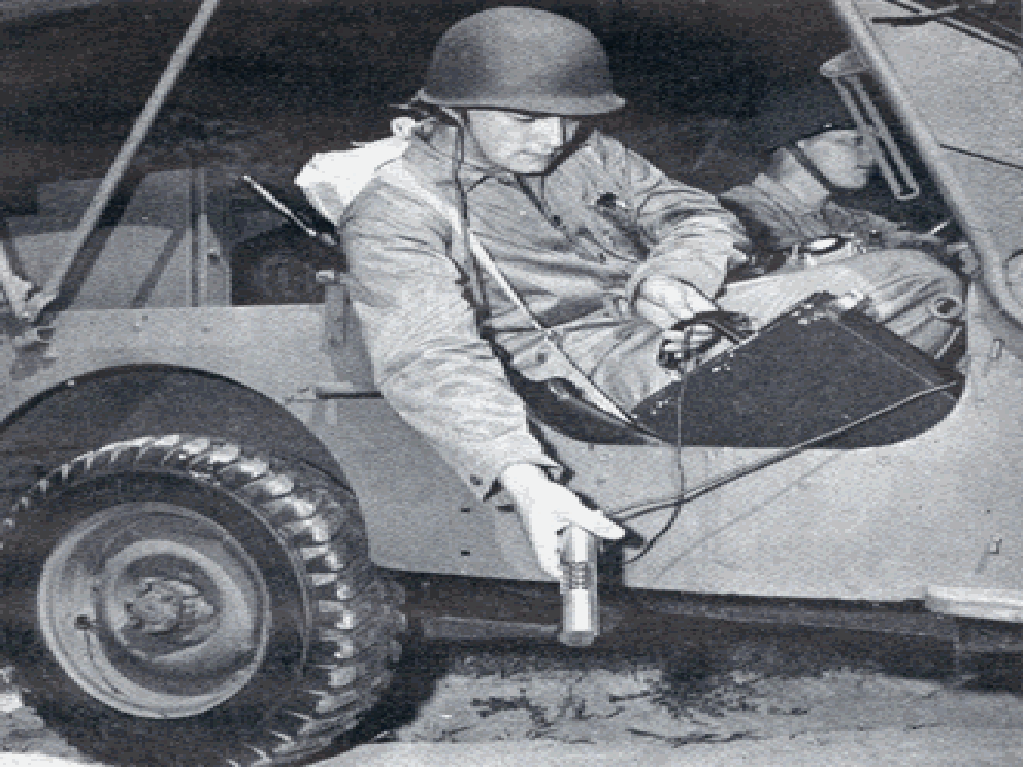
Soldier in Jeep with Victoreen Model 263 1950
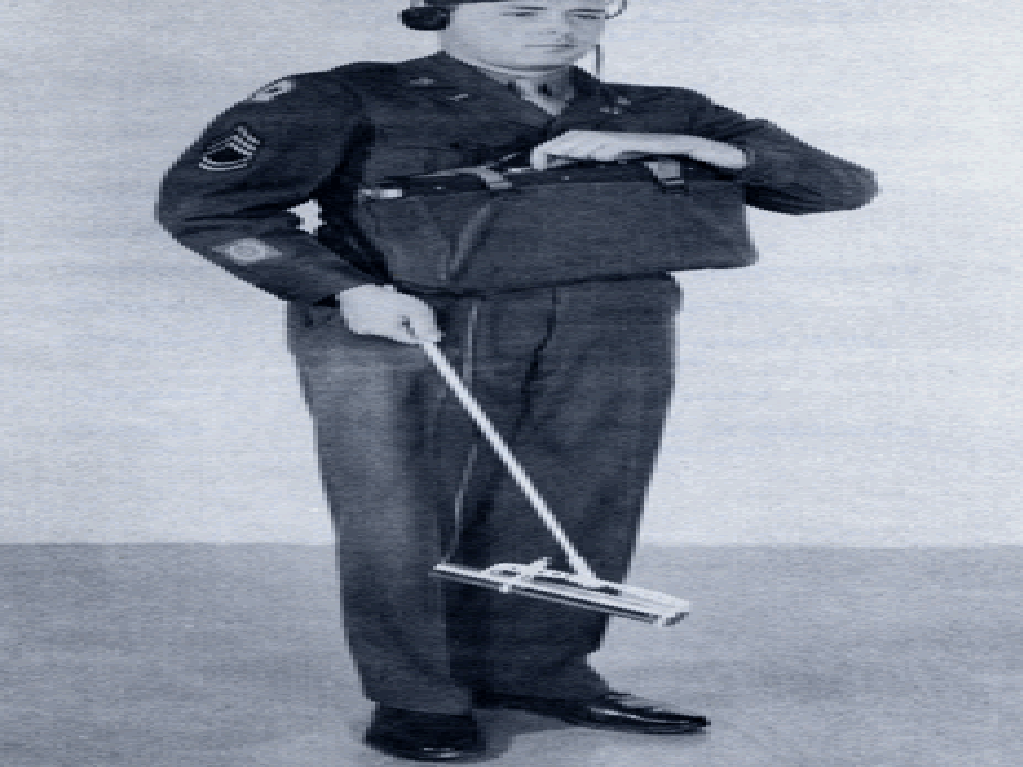
Soldier with Model 263 and long probe 1950

Victoreen Model 263 1948
The Model 263A (IM-1A/PD or AN/PDR-5) issued in 1948 and was an upgraded modification of the Model 263 after gaining four years or performance testing with military and civilian applications. The probe was streamlined by bringing the 24” cable out the end, knob length extended, three 300 volt batteries replace the special 960 volt battery and the weight is decreased by several pounds. The Model 263A is a portable beta gamma count rate meter with a thin wall glass 900 volt GM tube in an external probe introduced in 1947. The GM tube was filled with argon and ethyl ether. One hundred units were evaluated for possible use during Operation Sandstone in 1948 in the Pacific Island nuclear tests.
The unit was 12” x 10” x 3.25”. It weighs 13.4 lbs. The probe was 9” x 1.5” with a four foot cable. The probe was 9”x1.5”. It measures beta at 1000, 10,000 and 100,000 cpm. The gamma scale was 0.2, 2 and 20 mR/h. It can measure up to 0.5 R per day. The minimum beta energy detected was 0.3 MeV. The beta screen was 1/32” brass and the probe opening was 2”x2.5”. It used a 1.5, 67.5 and 900 volt batteries. It had a smooth paint surface with a hinged shiny leather handle. It came in black crackle or grey enamel. The unit sold for $200 in 1947. The operation Sandstone reports indicates that the 300 unit were to be delivered to the AEC by November 1947. It was also given a military designation denoted by AN/PDR-5. Some examples of its uses outlined in the 1947 manual include health hazards, decontamination, prospecting for radioactive ores, locating misplaced radium needles, and for postal inspectors to determine if shipping regulations are being observed.
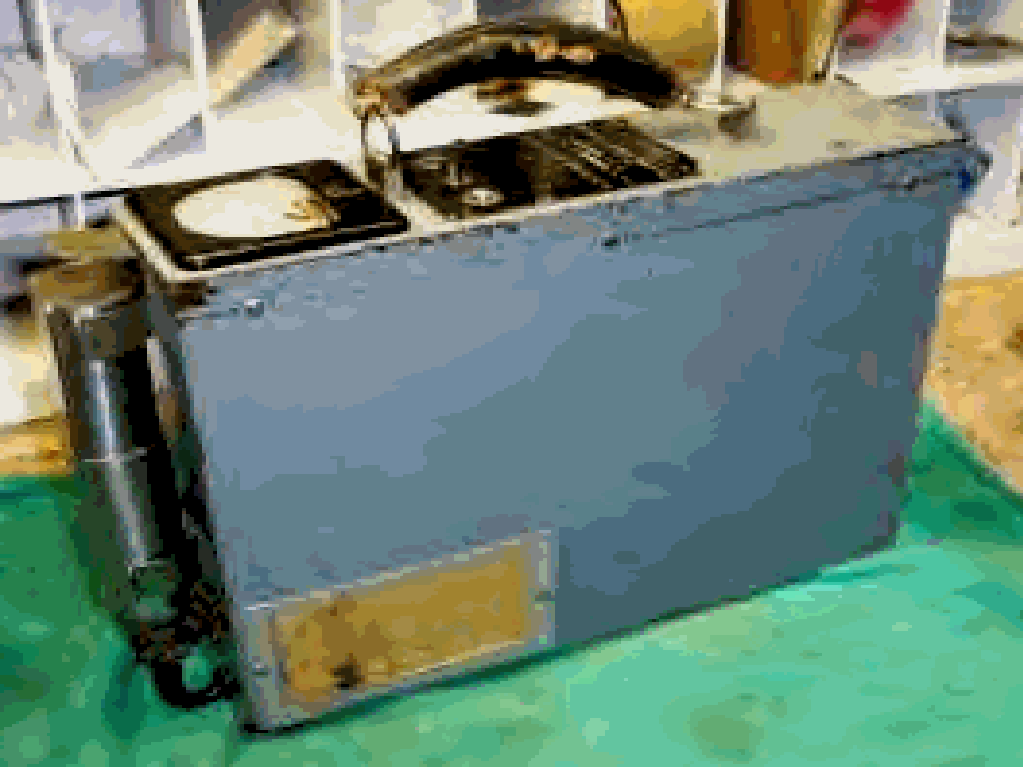
Victoreen Model 263-A 1951
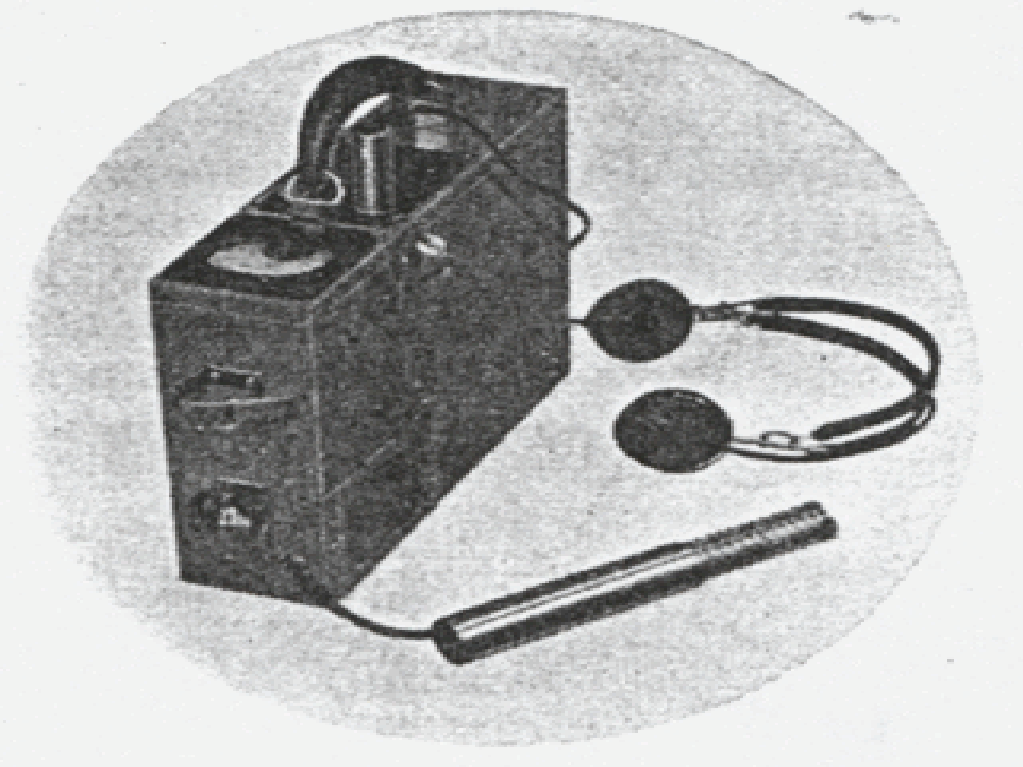
Victoreen Model 263A 1948
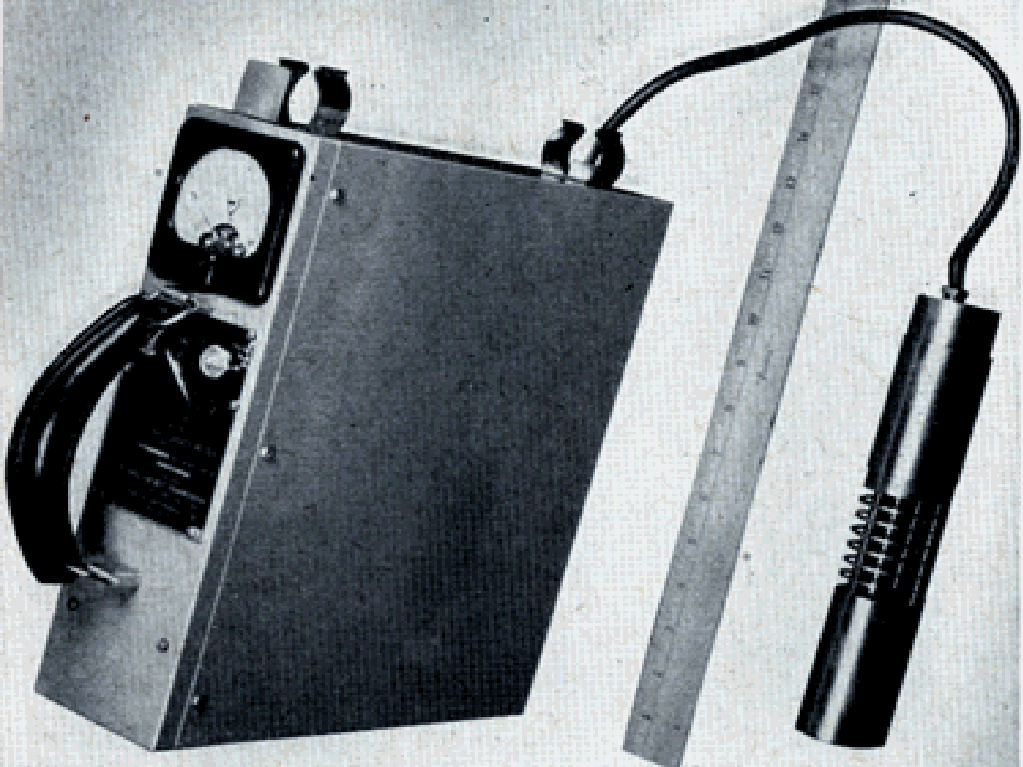
Victoreen Model 263A 1950
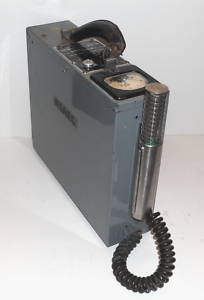
Victoreen Model 263-A 1950
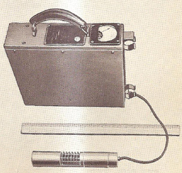
Victoreen Model 263-A 1951
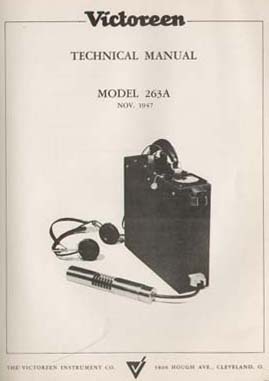
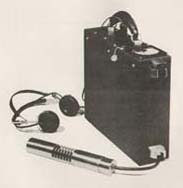
Victoreen Model 263-A Technical Manual 1947
The Model 263B is a modification of the Model 263A and was introduced in 1948. It has more rugged construction, decreased height, and decreased weight. The meter has three ranges 130, 1300, and 13,000 cps or 0-20 mR/h. Average intensity of beta gamma can be read from the micro-ammeter which is calibrated to gamma rays of radium. The Geiger counter is housed in a probe that is mounted outside the end of the case. The GM tube was filled with argon and ethyl ether. It used three 300V, one 1.5V and one 67.5V batteries. The unit weighed 11.5 lbs. The unit was used at the Los Alamos Scientific Laboratory in 1954. The military designation is AN/PDR-5A.

Victoreen Model 263B 1948
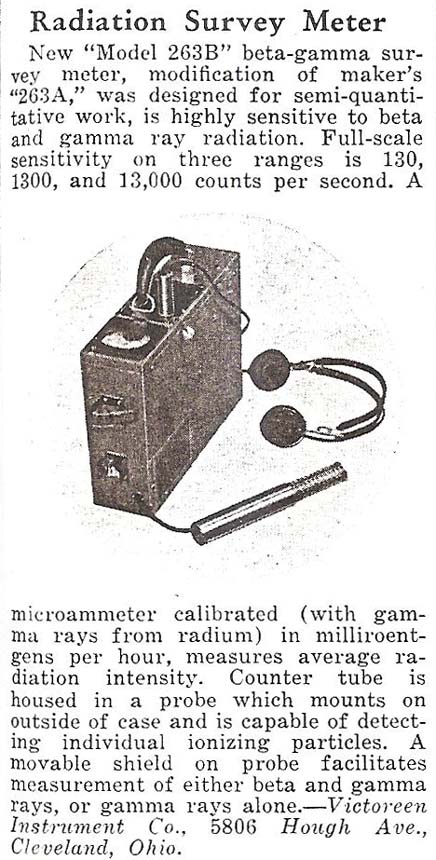
Victoreen Model 263B Ad 1949
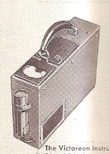
Victoreen Model 263B 1951
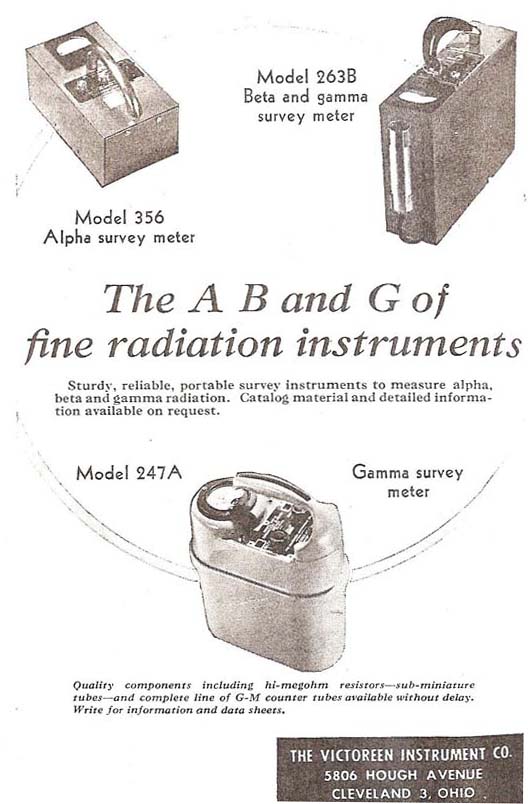
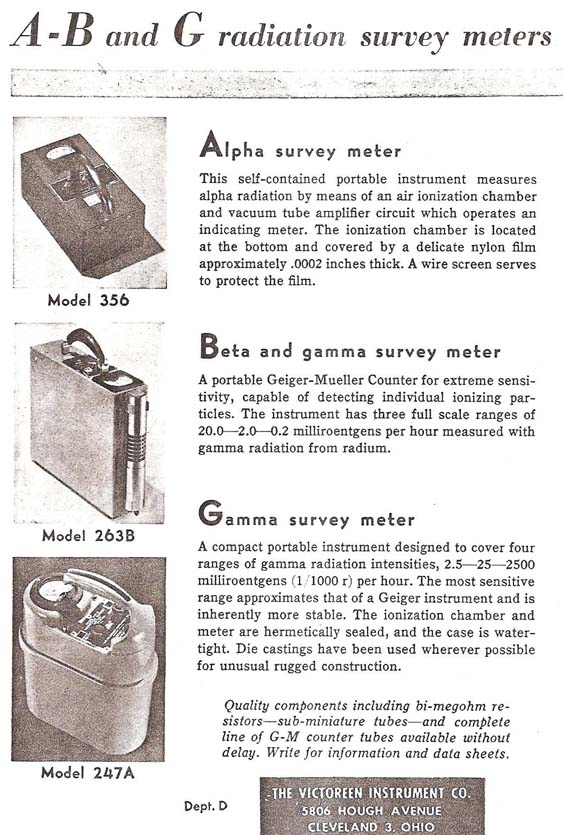
Victoreen Ads for Model 356, Model 263B and Model 247A 1949
The Minometer provides a prescription for computing in roentgens the daily exposure to radiation. The unit contains a small string electrometer and an ionization chamber designed in the shape of a fountain pen to be carried in your pocket. The chamber is 0.2 R full scale. The unit was available in 1948 for personnel protection.
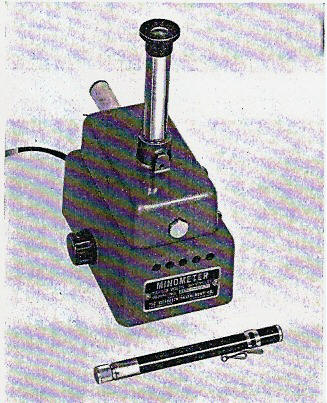
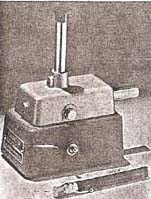
Victoreen Model 287 Minometer 1948
The Proteximeter Model 300 (AN/PDR-2) was a semi-portable direct reading integrating meter for measuring scattered radiation for the protection of roentgenologist, x-ray personnel, and those working around cyclotrons and Van de Graff generators in 1947. It measured total accumulated dosage of beta and gamma radiation. It used a condenser ionization chamber with a gravity discharging switch. Simply inverting it could discharge the chamber. It was a desktop unit with a meter on the top face. The midscale is 100 mR which is the accepted standard for a daily tolerance dose. The unit can measure up to 200 mR. The operating instructions are located on the bottom of the unit. It used five D-cell batteries which would last 1 month operating 8 hours a day. It is sensitive down to 30 keV with metal cap removed. The range was 0-200 mR/h. The unit measured 4” x 9” x 5” high (7” with chamber) and weighed 5 lbs. The chamber was 3” high x 3” diameter. The case was made of cast aluminum with a gray crackle finish. It used 5 D-cell flashlight batteries. The unit had a military designation of AN/PDR-2. The Model 300 was evaluated in Operation Sandstone was deemed “satisfactory but of little practical use”. The unit sold for $175 in 1948.
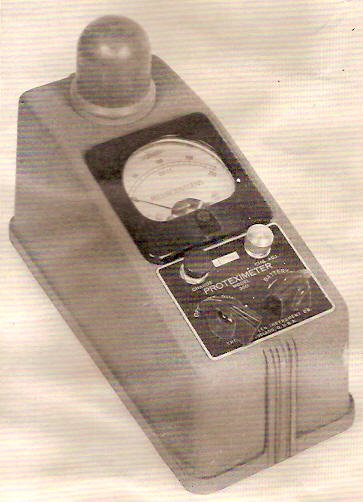
Victoreen Proteximeter Model 300 1947
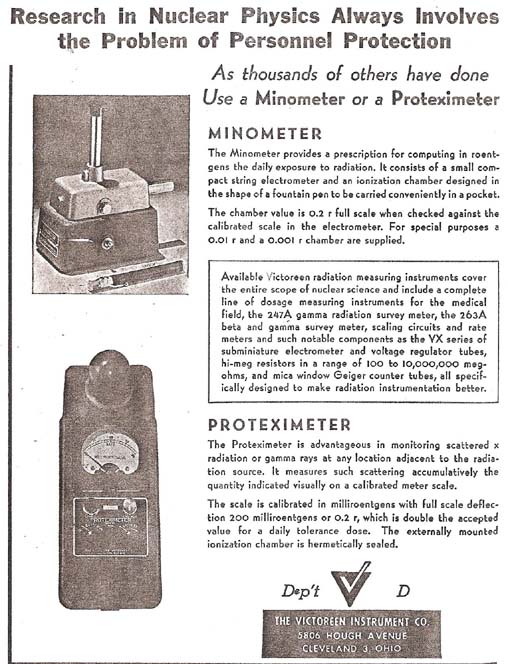
Victoreen Proteximeter Ad 1948
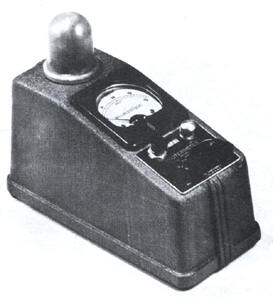
Victoreen Model 300 1949
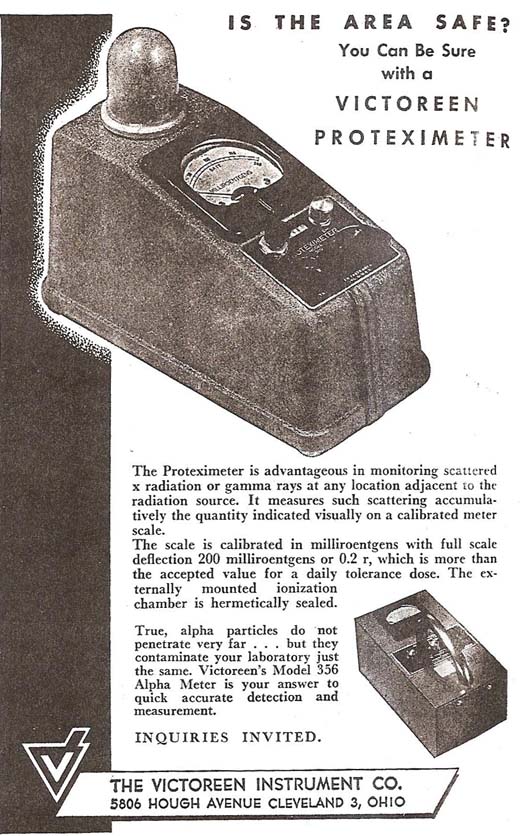
Victoreen Model Proteximeter Ad 1950
The Proteximeter Model 390 was a gamma area monitor offered in 1949. It was 9” x 4” x 4.5” high (7” with chamber) and weighed 5 lbs. It had a range from 0-50 R/h. The condenser ionization chamber was hermetically sealed. The unit is comprised of a charger base unit and a removable chamber. The chamber is charged by the internal circuitry and then either placed in an area to measure radiation, removed from the unit and carried by personnel, or removed from the unit and placed in the vicinity of personnel exposed to radiation. The chamber is 4-3/8” x 2” diameter and consist of a polyethylene envelope sealed in a hollow polyethylene case. It uses five 1.5 and two 30 volt battery. The meter scale and detector chamber are color coded magenta in accordance with radiac equipment coding.
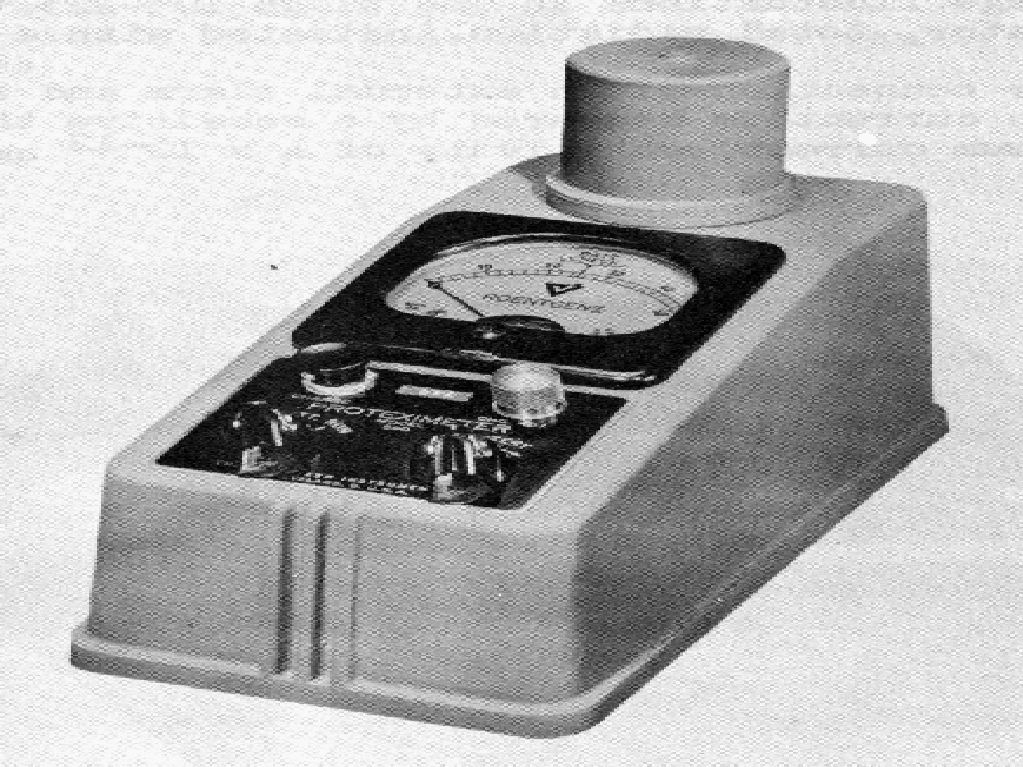
Victoreen Proteximeter Model 390 1949
The Model 392 was introduced in 1948 as variation of the Proteximeter. It had a range of 50R. The chamber was magenta colored with a magenta scale color. It measures 9” x 4” x 4.5” and weighs 5.25 lbs. The gravity discharge switch used in the Model 300 was replaced by a manual switch in the Model 392 to prevent accidental discharge. The chamber may also be detached for use away from the control unit.
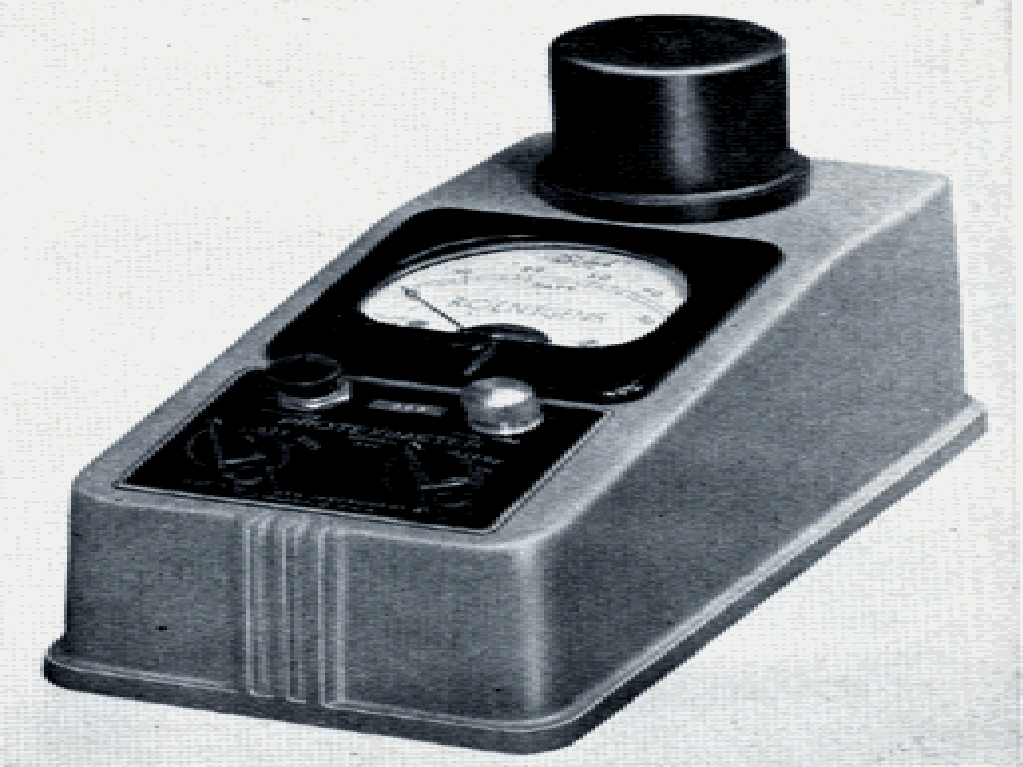
Victoreen Proteximeter Model 392 1950
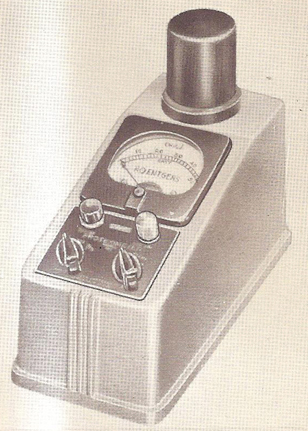
Victoreen Proteximeter Model 392 1951
The Model X-325 was a counting rate meter used at the Crossroads Tests in 1946. It was modified similar to the Barnaby drill hole probe to be used as a deep-sea probe.

Model X-325 GM 1946
The Victoreen Model X-323 is the commercial version of the Zeuto.
need photo
Victoreen Model X-323 Zeuto 1940's
The Model 337 Geiger-Mueller Counter was available in 1946. It was designed for industrial research. It had an external Geiger-Mueller tube. It operated on AC power and could supply up to 2000 volts. The front panel had controls for switching power, reset, start and stop counting, panel light indicators and aural monitoring with volume control.
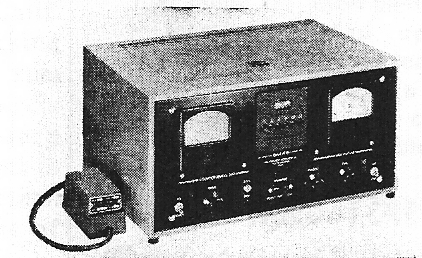
Victoreen Model 337 1946

Victoreen Model 337 Ad 1947
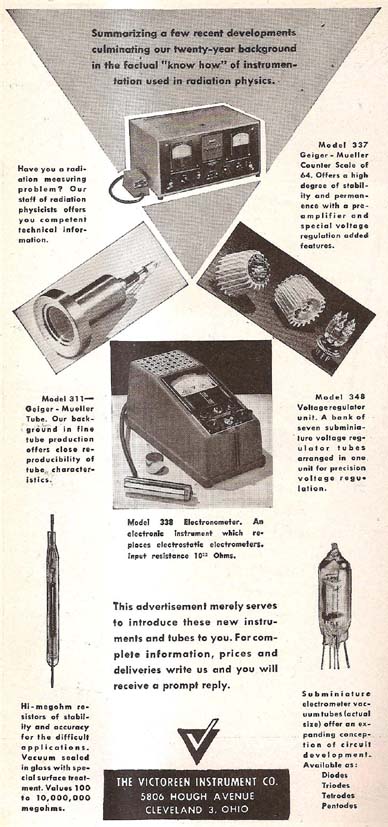

Victoreen Ads 1947
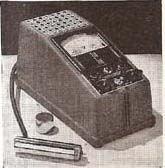
Victoreen Model 338 1947
The Victoreen Model 345 Alpha Survey Meter was introduced in 1949 for measuring moderate levels of alpha and beta radiation. It had a thin, flat air ionization chamber on the bottom and a thin nylon film window on the bottom. The window is protected by a wire screen. It had two ranges for alpha and beta. The X-1 range (5000 dpm alpha and 20 mR/h beta) and the X-10 range (50,000 dpm alpha and 200 mR/h beta).
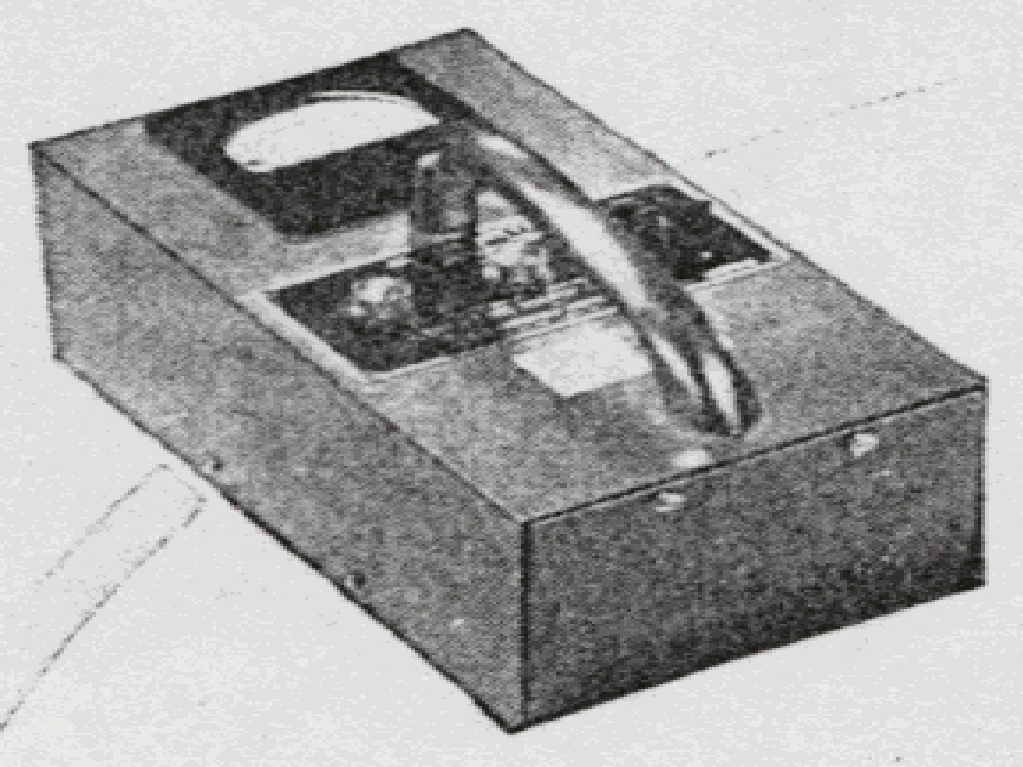
Victoreen Model 345 Alpha Meter 1949
In 1947, Victoreen produced the Model 356 Alpha Survey Meter for alpha detection for use during Operation Sandstone. Not sure if this is the same as the Pluto Alpha Meter from the same period. This was also designated by the military as the IM-4/PD.

Victoreen Alpha Survey Meter Model 356 1948
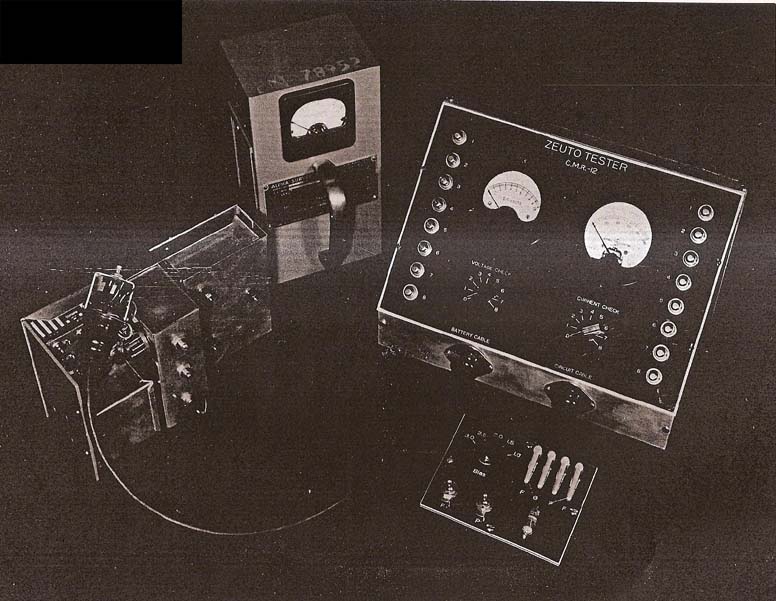
Victoreen Zeuto Alpha Meter with Zeuto Tester from Los Alamos National Laboratory 1948
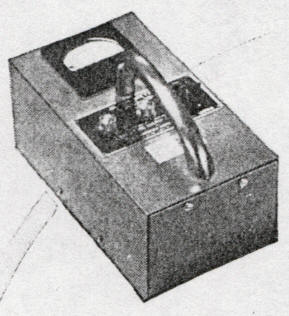
Victoreen Alpha Survey Meter Model 356 1949

Victoreen Ad with Model 356 1949
The Zeuto (Zuto) Alpha Survey Meter Model 356 is a portable alpha contamination meter designed after the Zeuto (MDDC-117) developed by the Metallurgical Laboratory at the University of Chicago. It was manufactured commercially by Victoreen in Jul 1947 and also designated as IM-4/PD for the military. It has an air ionization chamber. It weighs 8 lbs. It could detect alpha from 400 dpm and 40000 dpm, beta and gamma from 4 mR/h and 40 mR/h. There were no screens to discriminate type of radiation. It has an air ionization chamber operating at atmospheric pressure. The walls of the chamber form the cathode and the anode consists of a wire framework referred to as the “tree”. The ion chamber had a very thin nylon screen and was 475 cc. It was coated in aquadag. The minimum energy detected was 25 keV beta and 2 MeV alpha. It used one 1.5V battery for the filament, two 7.5V for the coupling and bias, and two 22.5 V for the plate and chamber. It was also designated AN/1 M-4PD. It was 9.5” x 5.25” x 4.25” and weighed 6-8 lbs. (1) Picture used with permission of the Stafford Warren Collection.
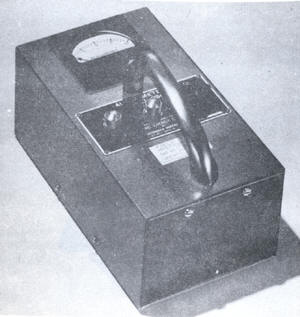
Victoreen Alpha Survey Meter Model 356 1950
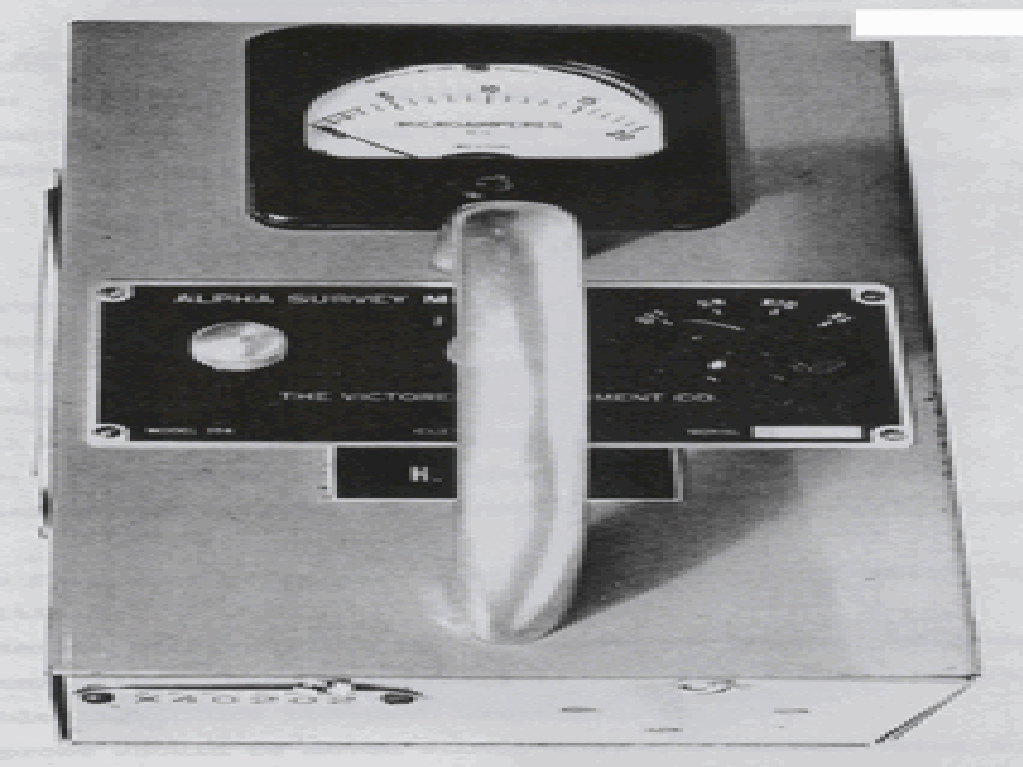
Victoreen Alpha Survey Meter "Zeuto" Model 356 1954
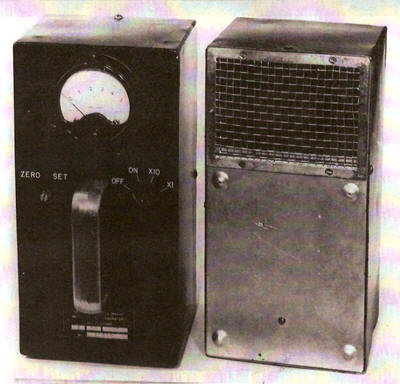
Zeuto1 instrument 1940's from Met Lab in Chicago was the predecessor to the VIctoreen Model 356
The Model 356 was evaluated as part of Operations Sandstone in 1948 as a backup in the event other units were not available. Twenty units were acquired with an air ionization chamber with two ranges of 8000 and 80,000 dpm, but received no formal testing. It was determined to be unsatisfactory for alpha measurements of fission products because of substantial beta-gamma response.
The Model 381 Integron IV was an integrating type area monitor for gamma and x-radiation instrument which can be designed to measure in roentgens various ranges of radiation intensity. There are indications that the first Integron models were available from Victoreen as early as 1944. It could measure from 0-500 R/h. It is designed for the radiologist for dosage control. It came with a sensitive thimble ionization chambers. The ionization chambers are hermetically sealed to overcome leakage due to humidity, dirt or lint particles. There is only one control knob on the panel. The unit has an adjustable floor pedestal for positioning counter to correct height. The unit weighed 20 lbs.
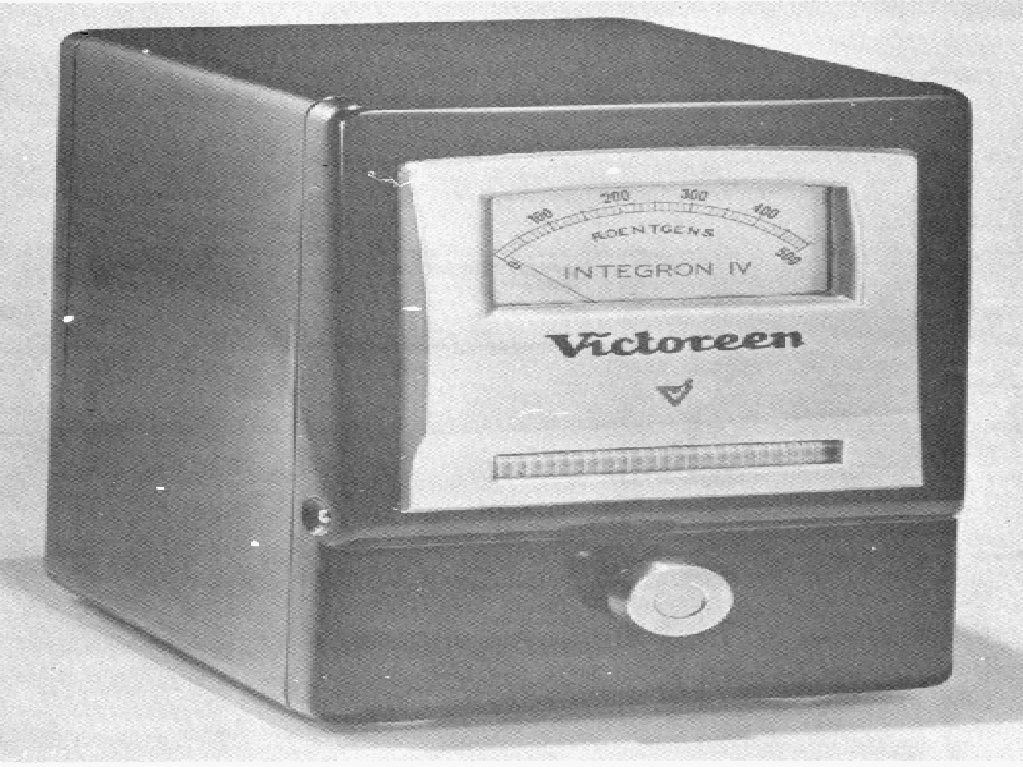
Victoreen Model 381 Integron IV 1948
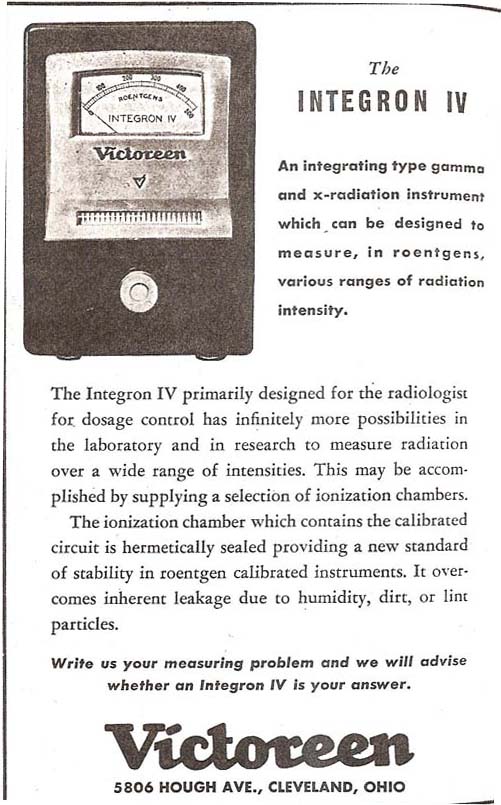
Victoreen Model Integron IV Ad 1948
The safe level at the time was 0.1 R per 24-hour period and many knew that there was a necessity to expose themselves to high dosages. A survey revealed that even the most daring would not expose themselves to over 10 R/h. It was recognized that this would happen at the criticality measurements at Omega, Ra-La measurements and the upcoming Trinity Shot. The Model 427 was designed as a Roentgenometer in 1947 for measuring to 10 R/h. Victoreen Model 427 was designed as a Roentgenometer in 1945 for measuring to 10 R/h. The model, however, was difficult to service in the field.
Need photo
Victoreen Model 427 1947
The Model SP-100 was introduced in 1949. It was a counter with an extension GM tube in an external probe. The unit measured clicks in the headphones for indications of radioactivity. The 900 volts is provided by three 300-volt batteries contained in the box with handle. The GM tube is 3/8” x 1-3/8” long.
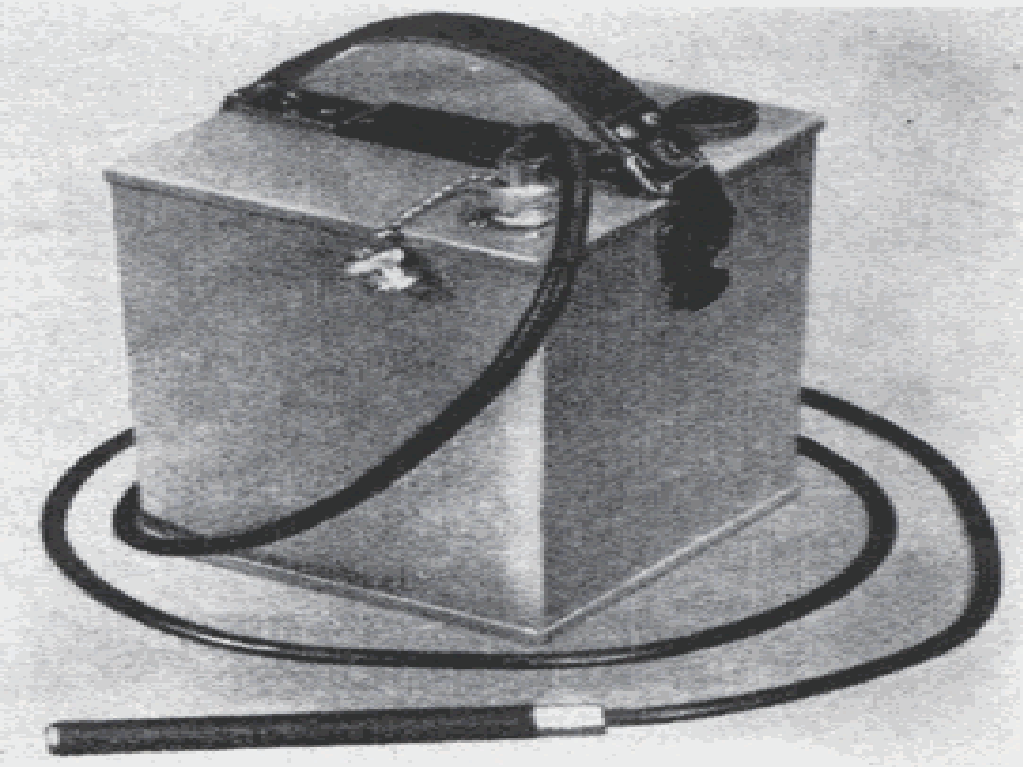
Victoreen Model SP-100 1949
The Victoreen Model 488 neutron survey meter was developed in the 1950's.
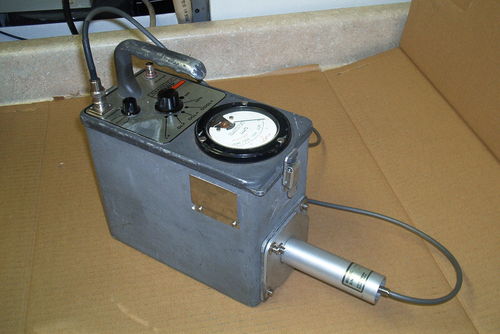

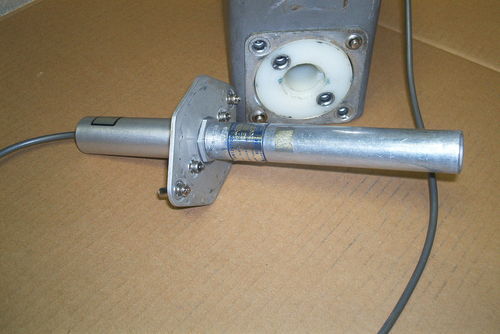
Victoreen Neutron Survey Meter Model 488A 1950's

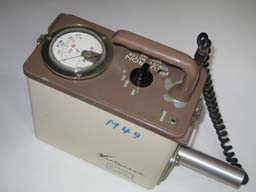
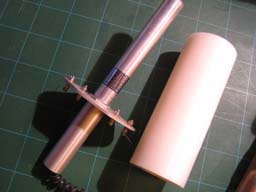
Victoreen Neutron Survey Meter Model 488 1950's (images provided by D. Fechner 2013)
The Roentgen Ratemeter Model 510 was sold in 1950. It consist of a thimble ionization chamber and preamplifier connected by a cable to a control unit. It was designed to indicate rate of beam intensity in roentgens per minute. Two probes are offered – the Model 510 which covers the range from 3, 10, 30 and 100 R/min and the Model 510A which covers the range from 30, 100, 300, 1000 R/min. It was 7” x 10” x 8” and weighs 20 lbs. It operates on 110V AC. Victoreen advertised in 1959 that “Victoreen….first to measure the Roengten accurately”.
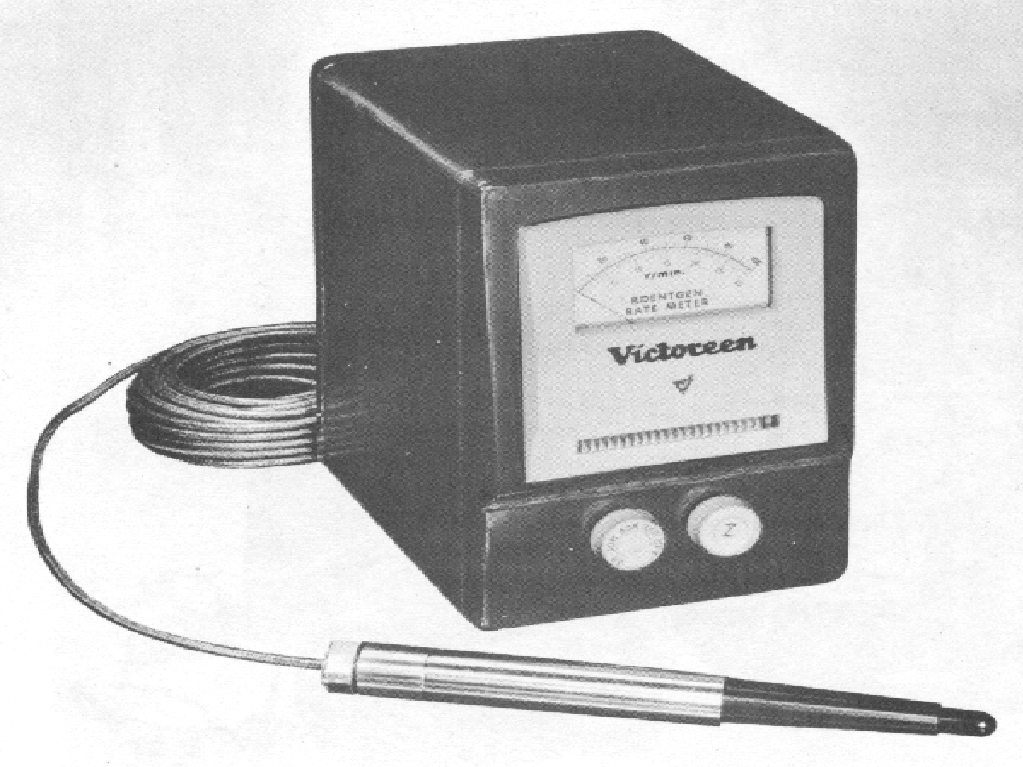
Victoreen Model 510 Roentgen Ratemeter 1950
The Model 518 “Tattler” was a gamma survey meter offered in 1950. The unit is a pocket geiger counter with audio indication with headphones. It was 2” x 2.5” x 4.5” and weighed 1 lb. It used one 1.5V flashlight battery. The tube was charged using a push button switch. It was advertised for three uses – detection of radioactive ore, warning for civilian defense and an educational toy. It had a green anodized aluminum or red crackle case.
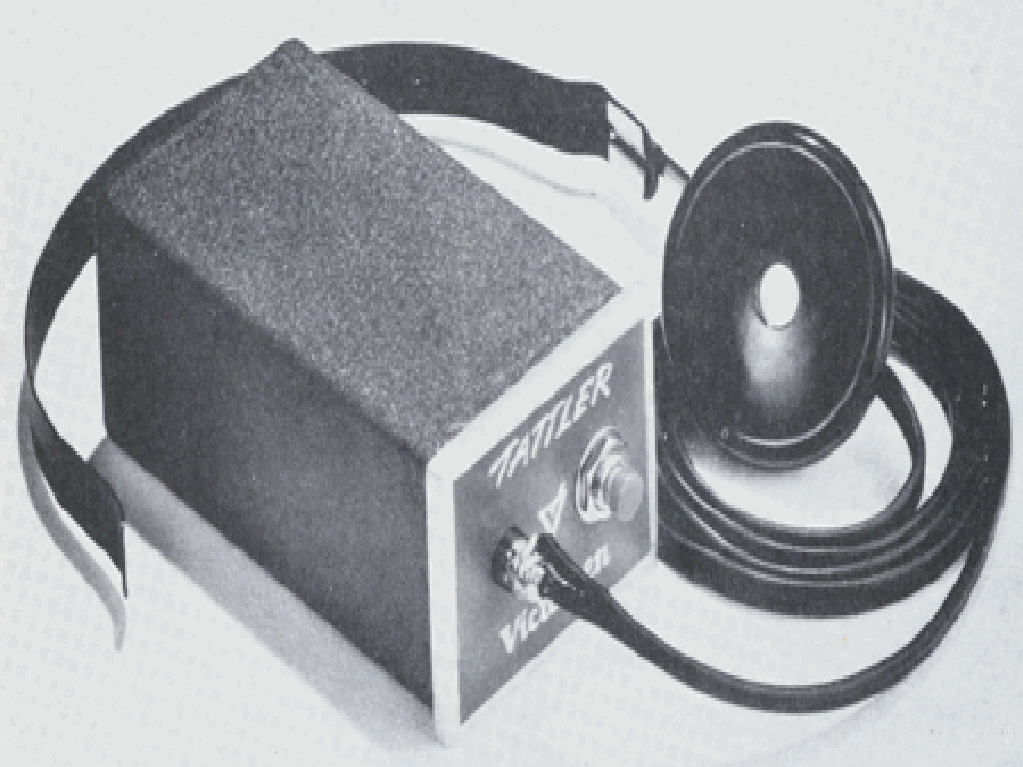
Victoreen Model 518 Tattler 1950
The Victoreen Isotope Rate Meter Model 524 was introduced in 1951. It was a laboratory-quality counting Geiger counter rate meter for detecting alpha, beta and gamma radiation. It was designed for medical or laboratory use in isotope research laboratories. Count rate ranges were from 0-300, 0-1000, 0-3000, 0-10,000, 0-30,000, and 0-100,000 cpm. A scintillation counter may be use with the meter. Aural and visual presentation is provided. A three position switch allow the operator to select the most desirable response speed. The probe was 1-1/4" x 5-1/2", weighed 3/4 lbs. and is connected via a 4’ cable. It operated on AC and had a grey baked enamel finish. The case was 7" x 10" x 8" and weighed 21.5 lbs. In 1955, it was designated Model 1524 and sold for $375.
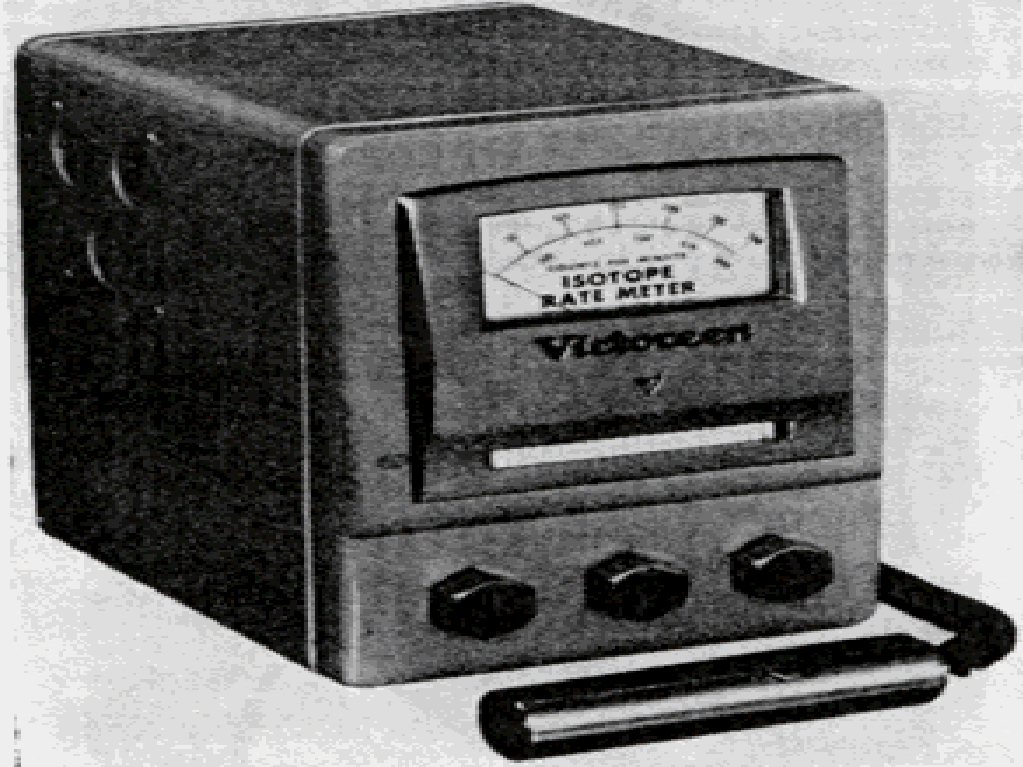
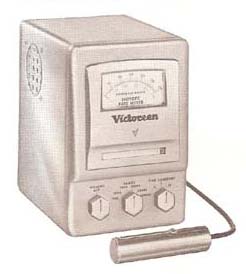
Victoreen Model 524 1951 (left) and Model 524A 1954 (right)
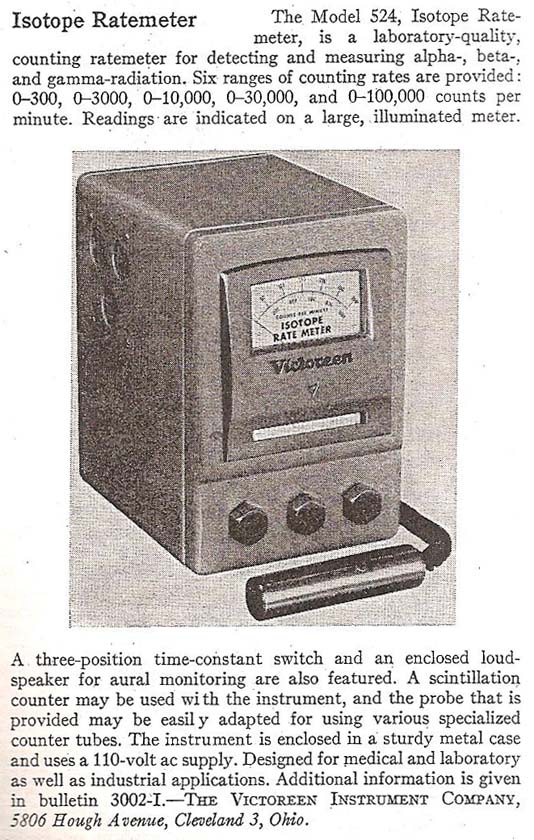
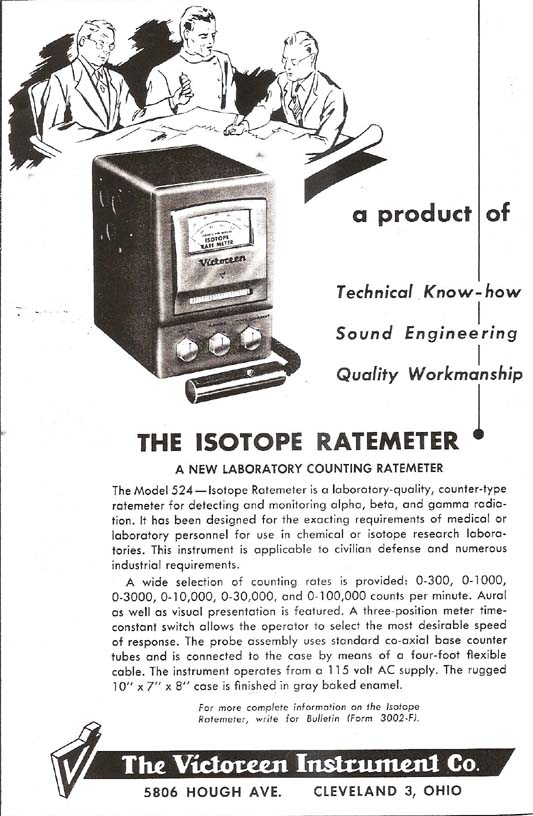
Victoreen Model 524 Ads 1951(left) and 1952 (right)
The Model 524A Laboratory Ratemeter was introduced in 1954 and uses the same case as the Model 524. It employed a Model 587 probe, a 1" x 1" NaI scintillation crystal with dimensions 2" dia x 8-1/8" long and weighed 1.5 lbs. It was AC powered with a meter and built in loudspeaker. It is calibrated in cpm. It has 6 sensitivity ranges and only three controls. It also has 3 time constants. In 1955, it sold for $545.
The Radiacmeter Model 543 (IM-78 AN/PDR-10B) was introduced in 1952. It was a portable alpha survey meter. It had a large window with a removable cover located on the case bottom next to the counting chamber. It had an illuminated meter and headphones. The detector was an air proportional chamber. The range was 0-10000 dpm on a two decade semi-logarithmic scale. It used six 22.5 and two 1.3 volt mercury batteries. Battery life was 40 hours. The unit was 14.5” x 4.5” x 6.5” and weighs 8 lbs.
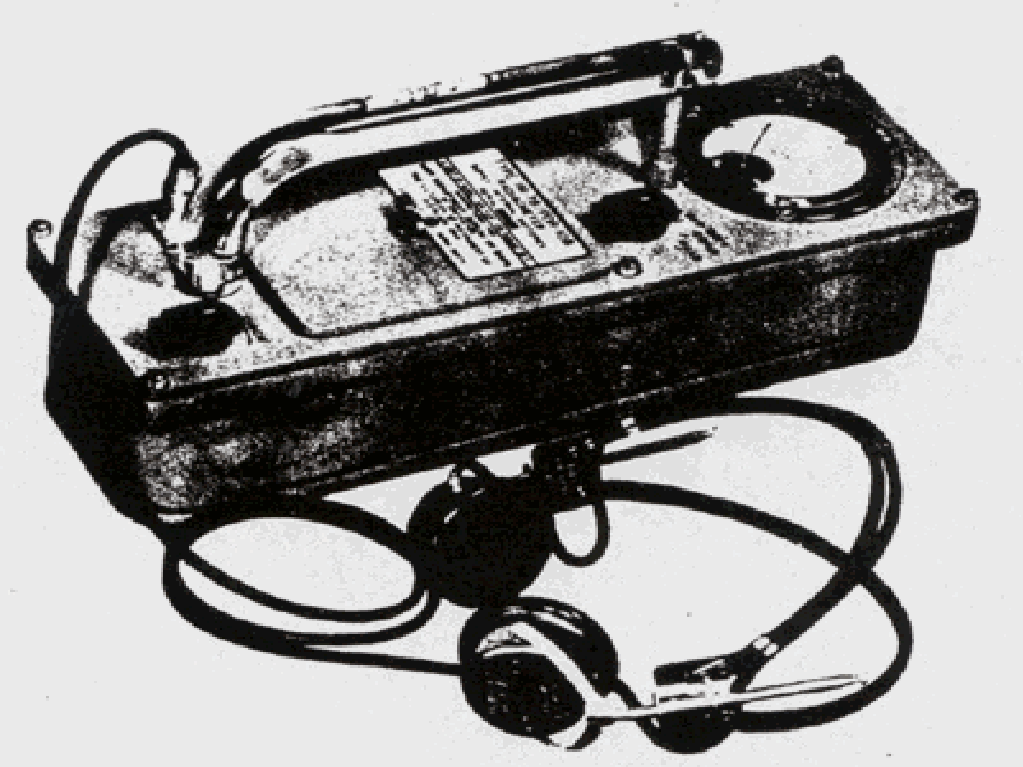
Victoreen Radiacmeter Model 543 1952
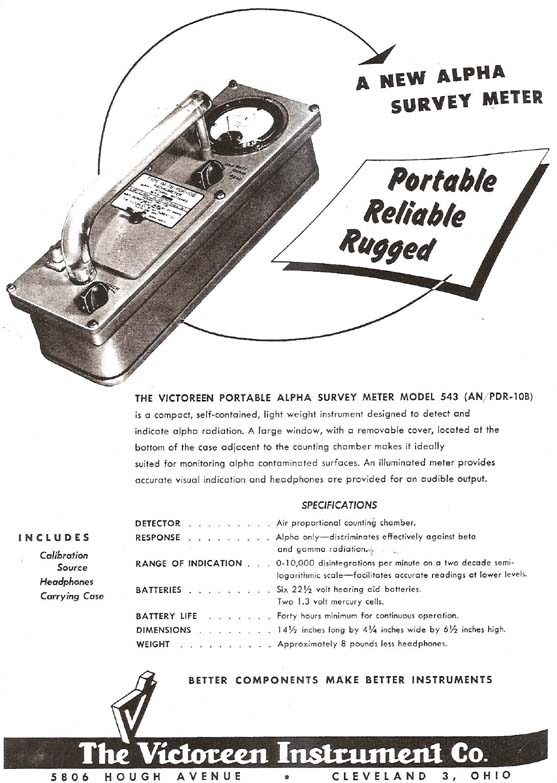
Victoreen Model 543 Ad 1952
The AN/PDR-10 Model A and D were the standard Air Force alpha instrument in 1957. The sensitive probe area is about 2” x 8”.
The Model 573 “Isotope Comparator” was offered in 1953. It had 10 bismuth cathode type Geiger tubes. It has six ranges with a scale reading in percent. It had a removable shield to permit beta measurements. The unit measured 14” x 6.5” x 9-3/8” and weighed 18 lbs.

Victoreen Isotope Comparator Model 573 1953
The Model 575 Radocon was introduced in 1953. It was a roentgen calibrated integrating ratemeter with thimble ionization chambers. There were eleven models from Model 601-611. It had three ranges 10, 30, and 100 R/min. Probes can be connected at ranges up to 200’. The unit was primarily designed for x-ray measurements in the medical field.
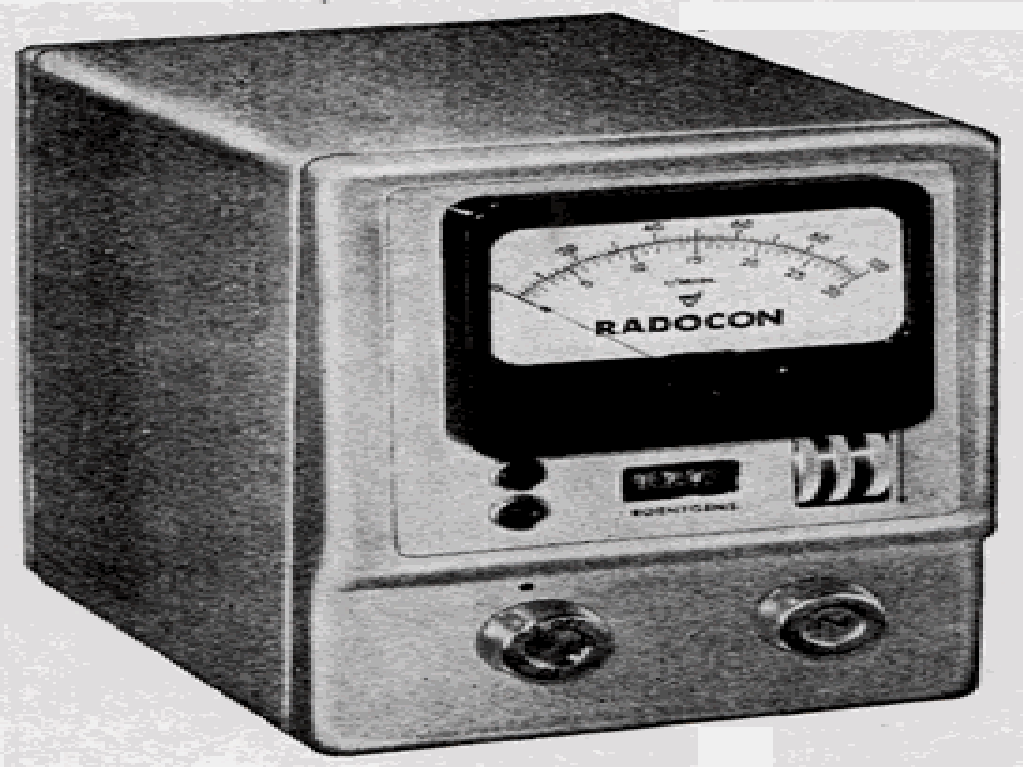
Victoreen Radocon Model 575 1954

Victoreen Radocon Model 575 1954
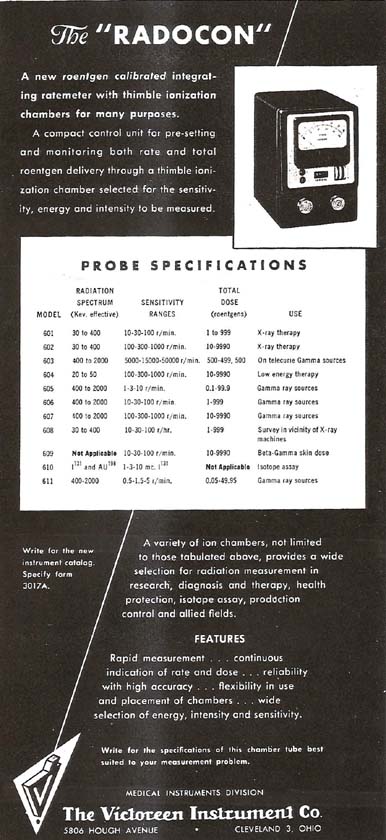
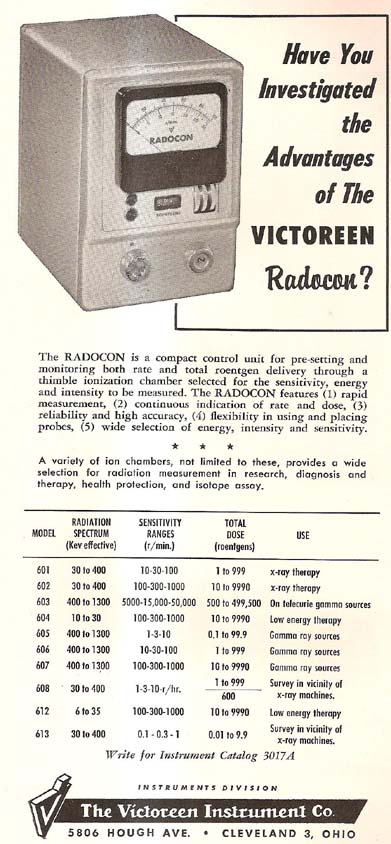
Victoreen Radocon Ads 1953 (left) and 1955 (right)
The Model 592 was introduced in 1954 by the Medical Instruments Division of Victoreen. It was designed as a gamma dose rate survey meter. It was factory calibrated on x-ray, radium or cobalt-60. It gives of dose rate from 50 keV to 1.3 MeV with 10% accuracy. It comes with an internal ion chamber that is hermetically sealed and thus unaffected by humidity, temperature or pressure. It has two controls – an on/off range switch and zero set. It has a rugged, fiber glass reinforced case which meets military requirements and is easily decontaminated. It weighs 4.75 lbs. The Model 592 has sensitivity range from 10, 100 and 1000 mR/h. The Model 592A has ranges from 5, 50 and 500 R/h. The unit was still offered in 1958. The Model 592B was designed for the US Navy. It could read from 0-10 mR.
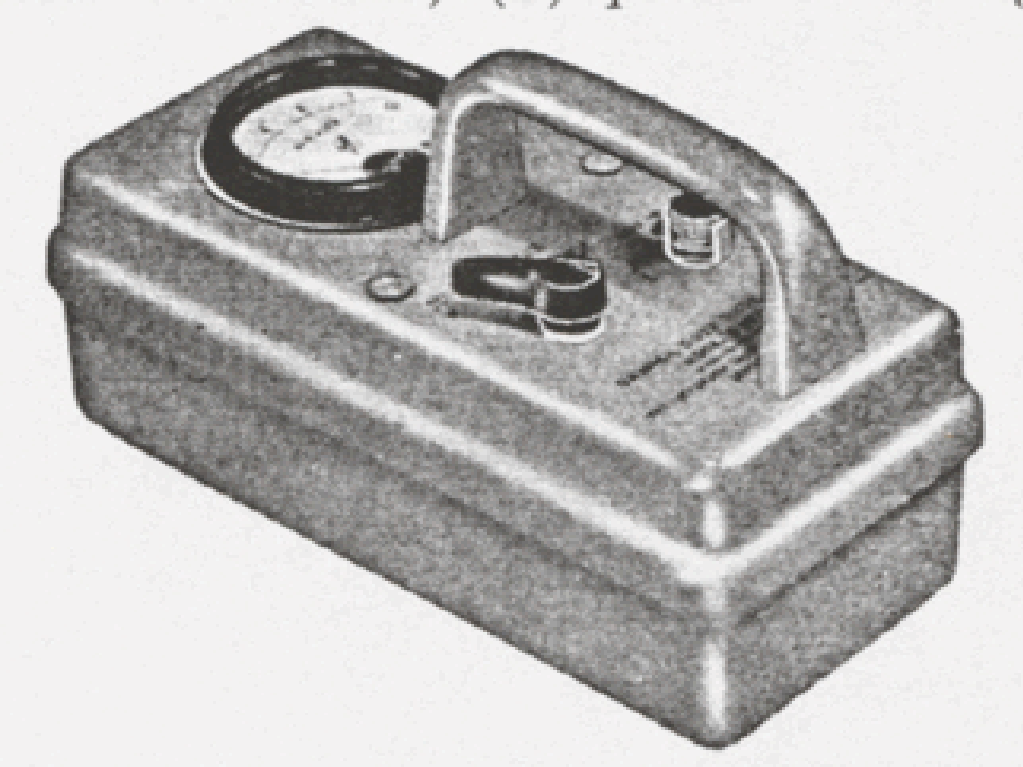
Victoreen Model 592 1954
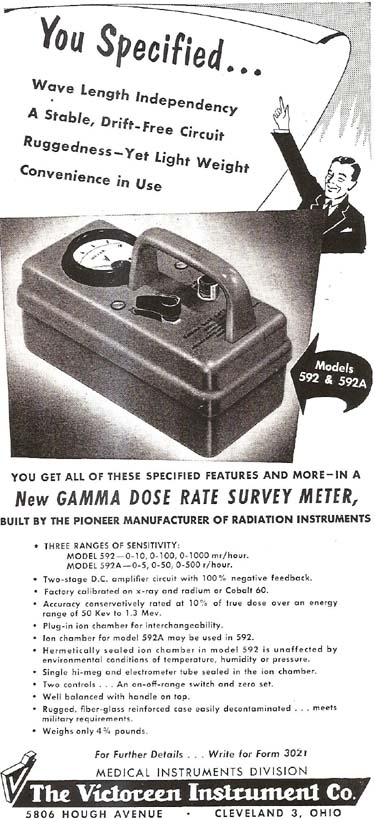
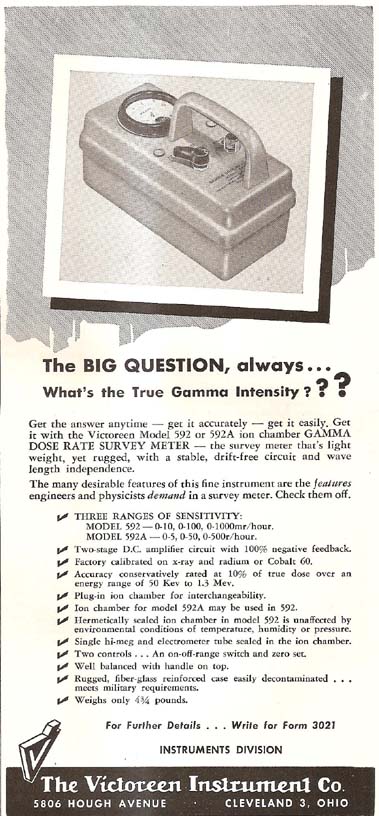
Victoreen Model 592 Ads 1954 (left) and 1955 (right)
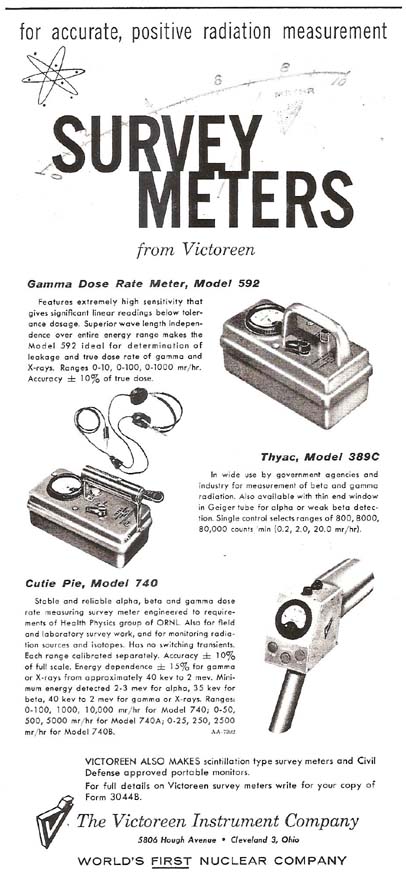
Victoreen Ad 1958
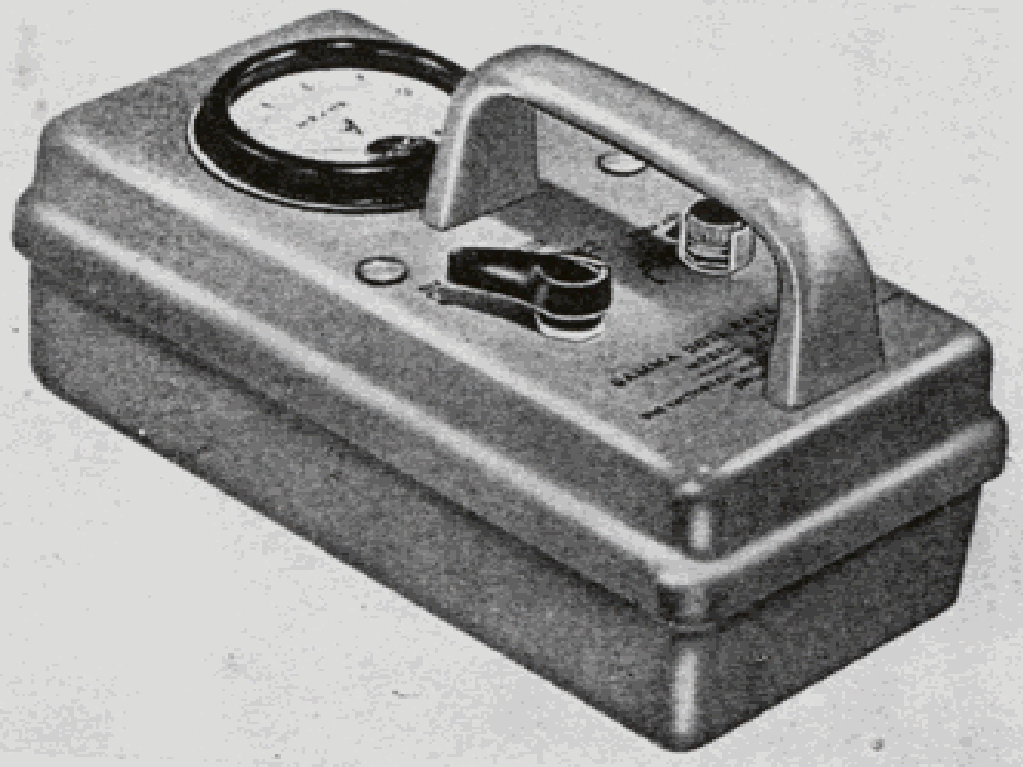
Victoreen 592B 1955
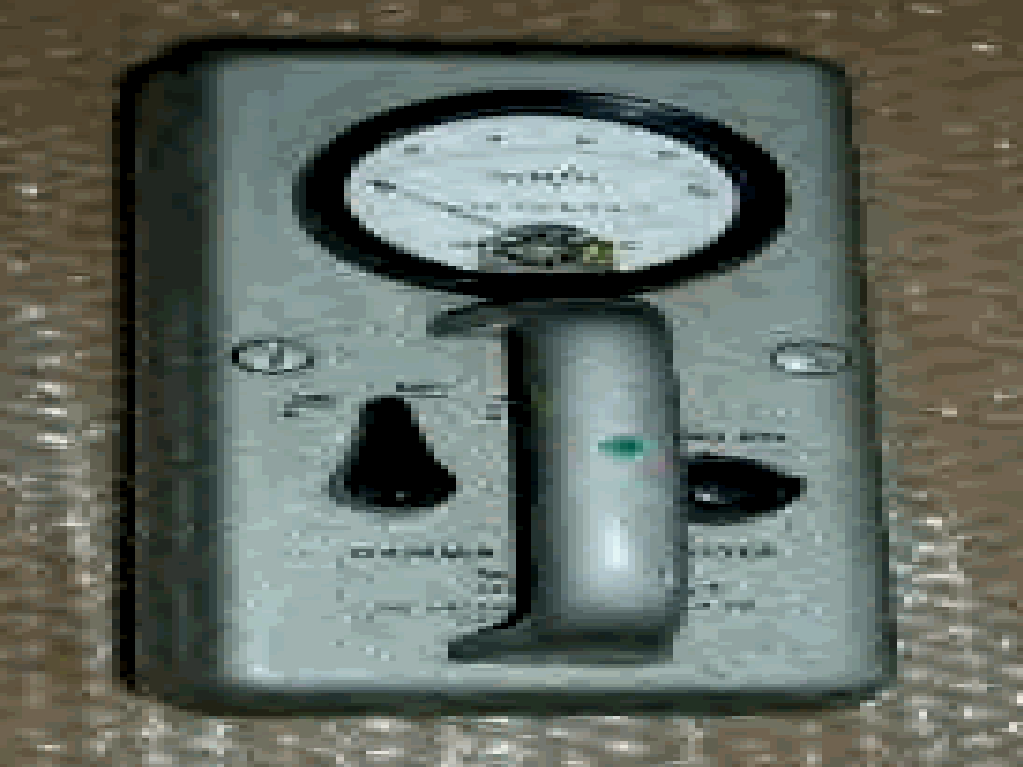
Victoreen Model 592B
The Victoreen Monitron was an area monitoring instrument offered in 1945. It was an instrument for the measurement and recording of radiation with an alarm. It had two scales 25 and 125 mR/h. It operated on AC.
Need photo
Victoreen Monitron 1945
The Victoreen Iometer was used to measure x-ray intensity. It could be used with the Condenser r-Meter. It also has an ionization chamber permanently mounted in a master cone and connected with a shielded cable.
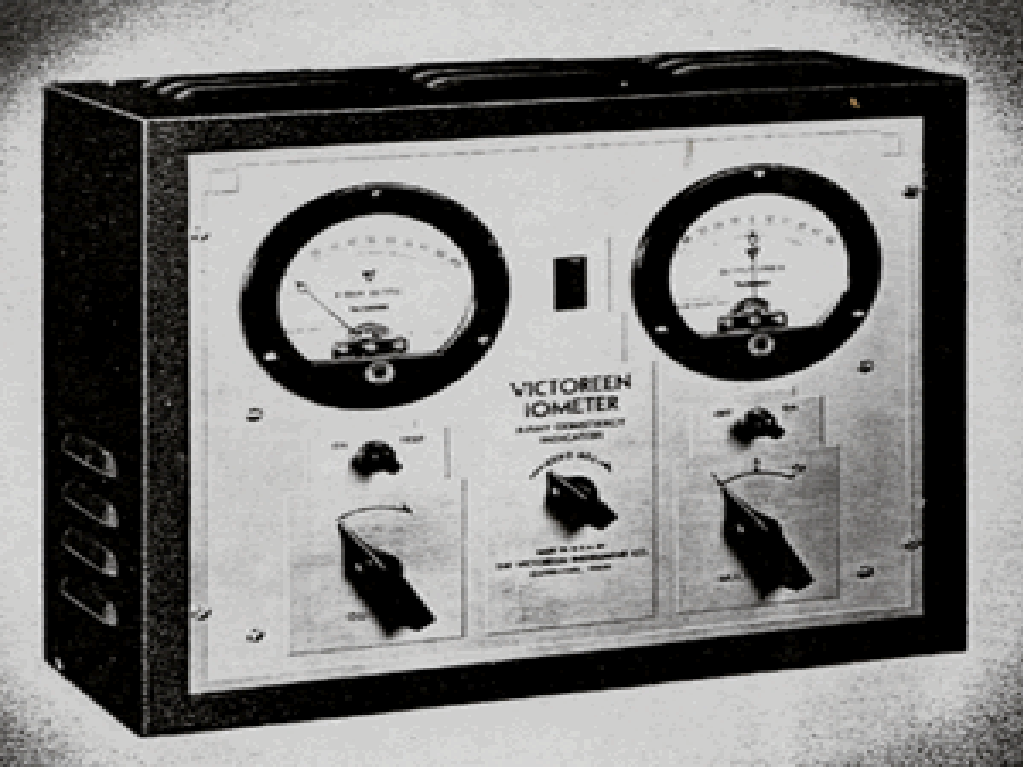
Victoreen Iometer 1950's

Victoreen Iometer Ionization Chamber 1950's
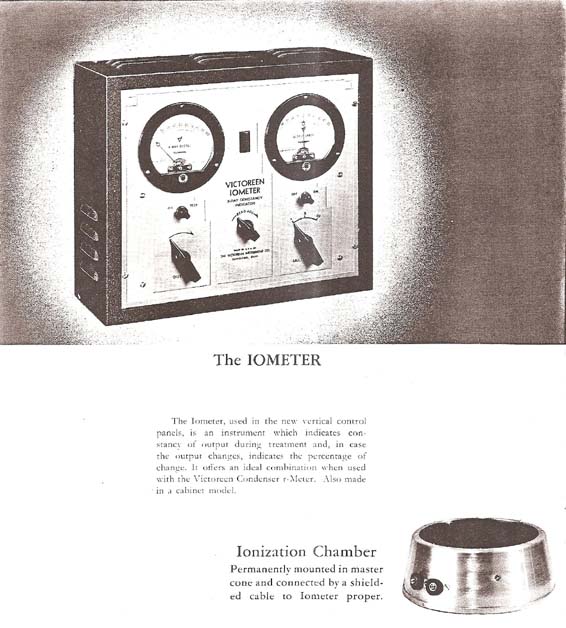
Victoreen Iometer Ad 1950's
The Vic Tic Model 631 was a full sized professional Geiger counter with a transistorized amplifier, loud speaker adjustable in tone pitch so that it could be heard up to 100' away. It was described for use on "for vacation and part time prospecting and school science class". The speaker was advertised "so that it may be distinctly heard, even in a boiler factor". It was introduced in 1955. It came in a distinct gold color or bright red. Earphones were not required. It used one 1.5 volt and one 67.5 volt batteries. It was 6.5” x 4.5” x 3.5” and weighs 3 lbs. It has four sensitivity ranges from 200, 1000, 10,000, and 100,000 cpm. It contained an internal aluminum walled Geiger tube, batteries, and radioactive sample. It was a complete package for $125 in 1955. The unit also has a radioactive source built in it. Also available was a hand probe ($19.95) and a deep hole probe. It was designed by the same engineers that developed the first instrumentation for Atomic Science.
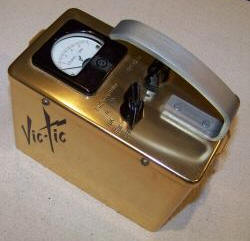
Victoreen Vic Tic Model 631 (Gold) 1954
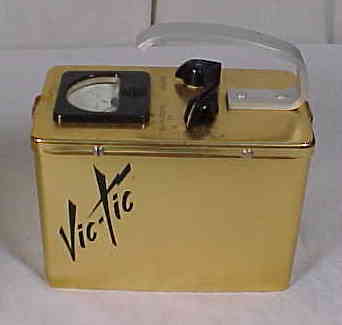
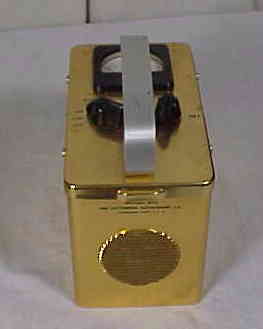

Victoreen Vic Tic Model 631 (Gold) 1954
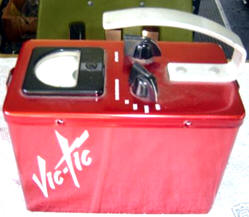
Victoreen Vic Tic Model 631 (Red) 1950's
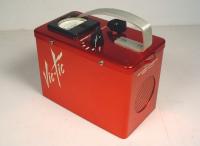
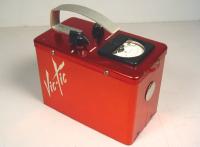
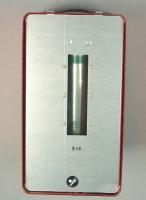
Victoreen Vic Tic Model 631 (Red) 1950's

Victoreen Vic-Tic Ad 1955

Victoreen Ad 1955
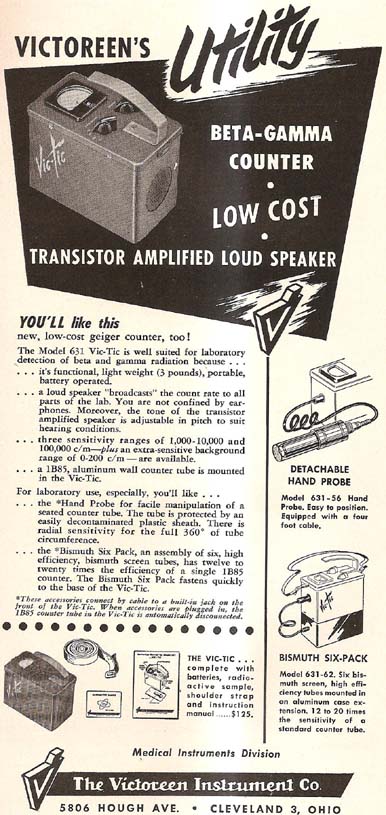
Victoreen Vic-Tic Model Ad 1955
In 1955, optional accessories included a “Bismuth Six Pack” which was a six pack of high sensitivity bismuth screen tubes. The Six Pack is 12-20 times more sensitive than a single geiger tubes. The six pack attached to the bottom of the unit using a plug in jack. It weighed 1 lb. and sold for $115. Another accessory was the deep hole probe, up to 200' for exploring well holes, drill holes, canyon or valley outcrops of rock to search for uranium. The probe is 3/4" dia x 12" long and sold for $95. And lastly, a detachable probe could be used for checking outcrops, rocks, etc. The hand probe is in a molded tenite gripper and tube socket with a plastic protective cover connected by a 4' cable. It sold for $19.50.
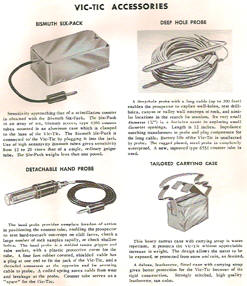
Victoreen Vic Tic Accessories
Need photo
Victoreen Vic Tic with Bismuth Six Pack
Between 1955 and 1956, Victoreen cut the price of the Vic-Tic instrument in half from $125 to $62.50.
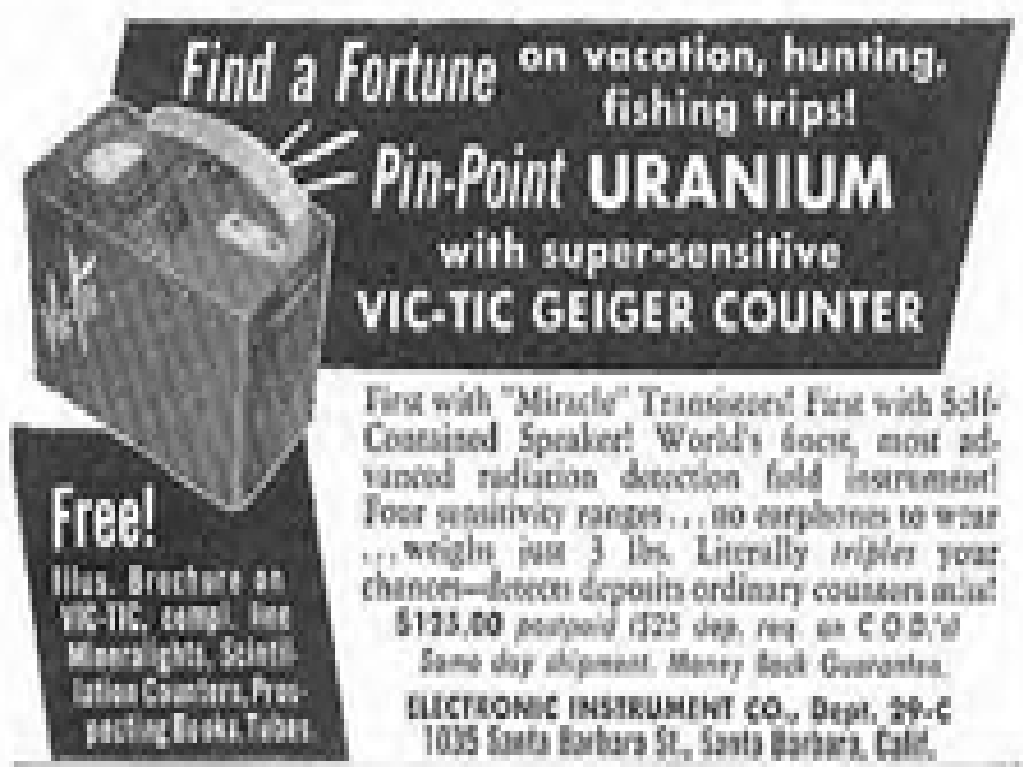
Victoreen Vic-Tic Ad 1955
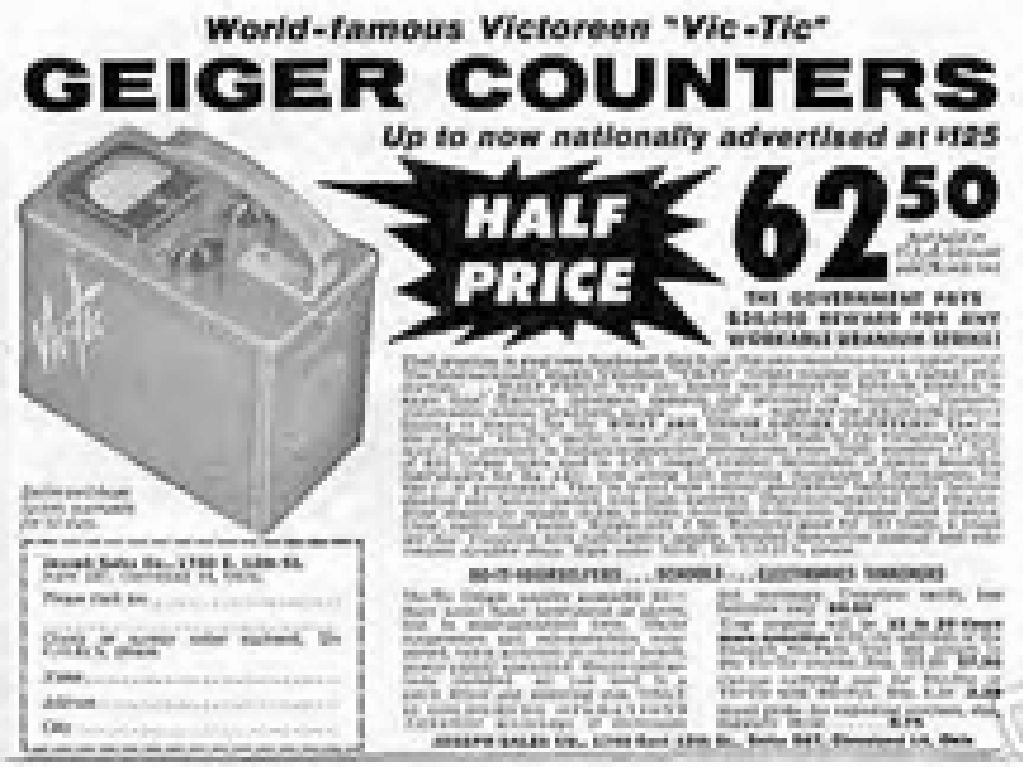
Victoreen Vic-Tic Ad 1956
In 1955, Victoreen introduced the “Victor Series” comprises radiation counters for uranium prospecting and gamma radiation detection. The units used either Geiger tube or scintillators. Some combination counters with two detectors were also available. All models offer 14 overlapping sensitivity ranges from 15 to 30,000 cps with time constants between 0.5 and 10 seconds. They can measure up to 1,800,000 counts per minute. The meter was 3.5" raised with counts per second. Uranium-thorium ore differentiation is included on some units. Most models are under 6 lbs.
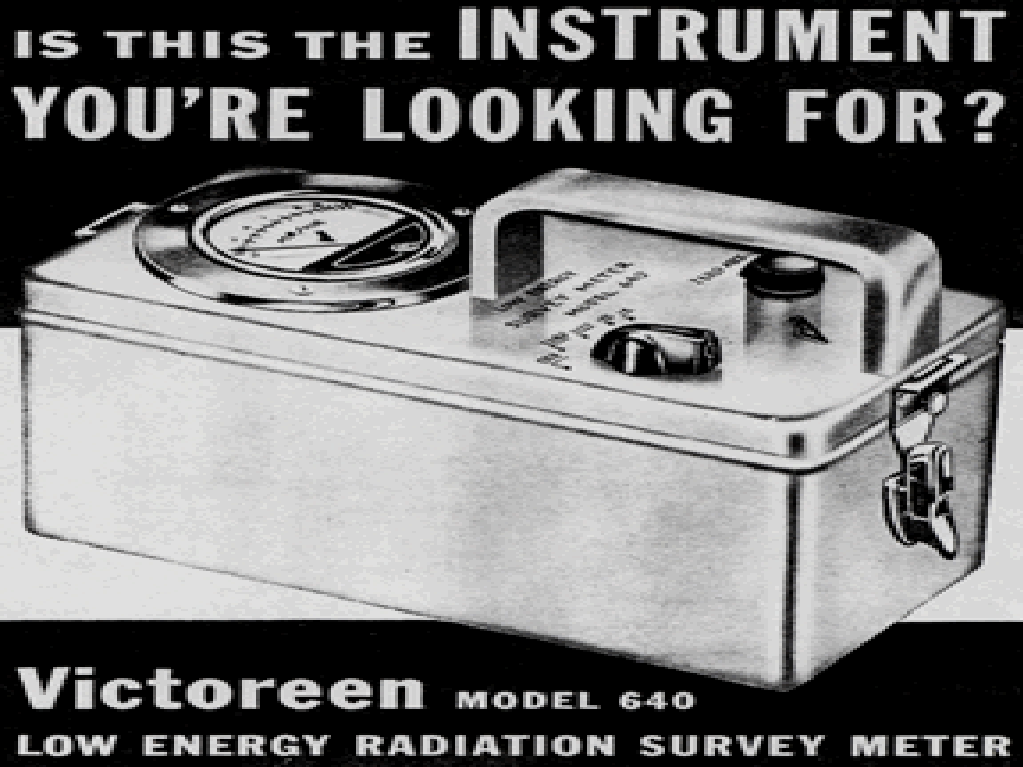
Victoreen Model 640 Ad 1956
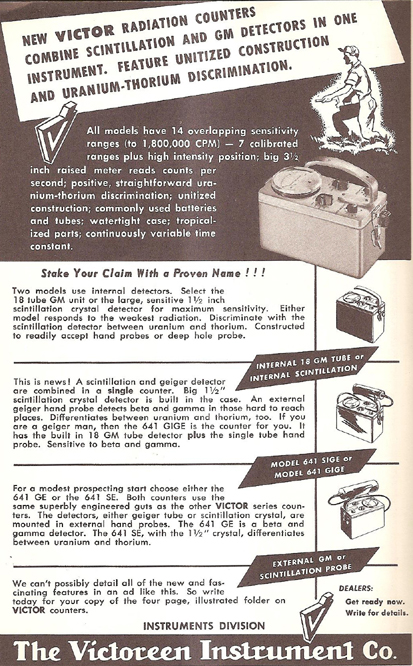

Victoreen Model 640 Ads 1955 (left) and 1956 (right)
The Model 640 was introduced in 1956 as a low energy radiation survey meter. It was designed to measure low intensity radiation from x-rays generated by magnetrons, thyratrons, and high voltage equipment. It can measure down to 6 mR/h. It can be used to check TV sets, x-ray machines such as fluoroscopes, and shoe fitting machines. Two energy ranges – 8-50 keV with a mylar window only and 50-2000 keV with bottom cover plate in place. Beryllium window is an option. It weighs 5 lbs. It has an aluminum case. It uses a mercury cell and eight 22.5V batteries.
The Model 641 SIGE is a combination detector with a Geiger Counter and Scintillator introduced in 1955. An external GM probe detects beta and gamma for hard to reach places. It also differentiates between uranium and thorium. The Model 641 GIGE has 18 GM tube detector plus a single tube hand probe. It is sensitive to beta and gamma.
The Model 641 GE is a beta gamma detector. The Model 641 SE is a scintillator with a 1.5” crystal and can differentiate between thorium and uranium.

Victoreen Model 641 1955
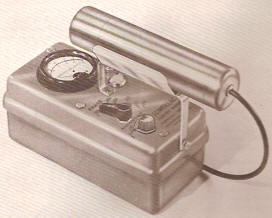
Victoreen Model 645 Scintillac 1955
The Model 645 Scintillac is an ultra-sensitive scintillometer with NaI crystal sizes from 1" x 1", 1-1/2" x 1-1/4", or 2" x 2". Phosphors were also available for alpha and beta detection. The detector is encased in a mu metal shield with a anodized aluminum cover to eliminate magnetic effects. The probe was 2" dia x 8.5" long. The unit was offered in 1955 and sold for $495 (1" x 1" NaI), $545 (1-1/2" x 1-1/4" NaI) and $970 (2" x 2" NaI). It has six ranges of 0-500, 0-1000, 0-5000, 0-10,000, 0-50,000, and 0-100,000 cpm, and four time constants - 1/2, 1, 3, and 10 seconds. The case was 10" x 4-3/4" x 8" and weighed 12 lbs. It is housed in a tough, watertight, reinforced, two section case.
This item is a real sleeper. It is an upgraded commercial version of the venerable CDV 700. It has improved circuitry inside, and includes a speaker to hear the clicks. An MHV connector is provided for probe attachment. Any standard 900 V probe will work with these, and I especially recommend the "pancake" style for super sensitivity to Alpha, Beta and Gamma radiations ( no probe is included).
Not a Geiger Counter exactly, but described as a "survey meter". This complete setup has two probes, one is 1" and the other is 4". Also a stand for the probes. The main unit operates from flashlight batteries. Sold on-line for $3200 new, $975 used.
Victoreen produced a variety of geiger tubes in 1956. They were the 1B85 (aluminum tube at 900V), the 6306 (bismuth tube at 900V), the 1B87 (sub-miniature at 900V), and the VG-18 (halogen).
In 1956, Victoreen offered the Scintigeiger. It could count to 1,800,000 cpm. It was a combination scintillation counter and Geiger counter. The internal scintillation crystal was 1.5”. It had an external Geiger counter probe. It has fourteen overlapping ranges. Sensitivity up to 12 mR/h . A two minute measurement test tells whether you have uranium or thorium. It sold for $575.
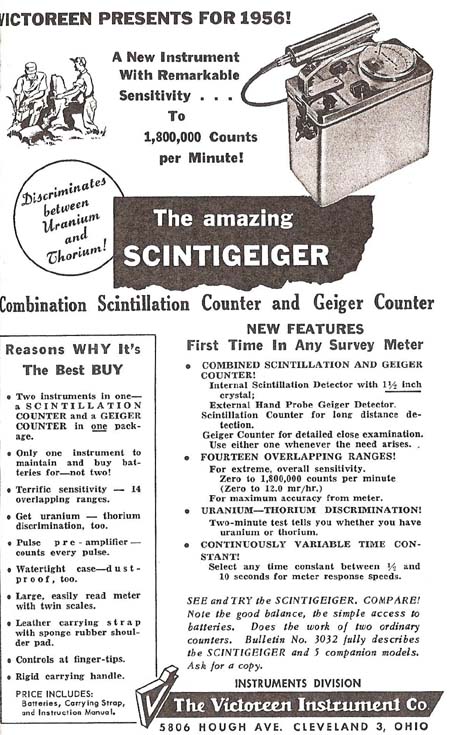
Victoreen Scintigeiger 1956
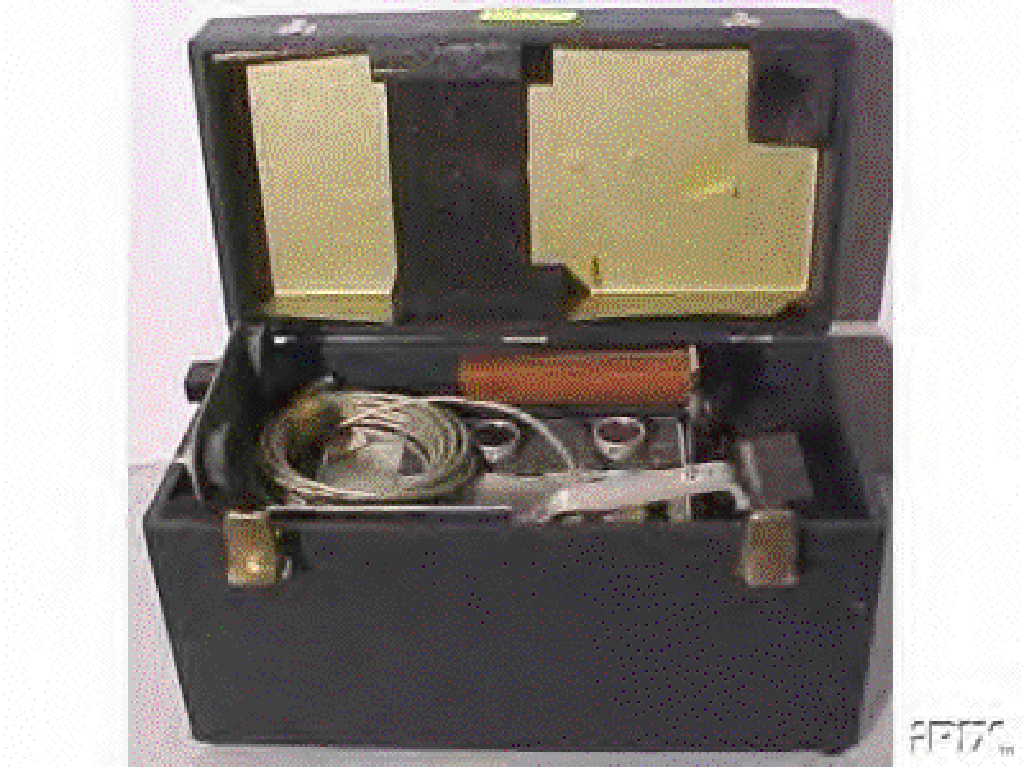
Victoreen Model 710
Here is an old radiation meter in unknown condition that is being sold AS-IS. It was made by Victoreen and is model Thyac III. It scales 0 to 0.2 mR/h and 0 to 800 c/m with ranges of 1, 10, 100 and 1000. There are also switch settings for “SCINT”, “GM” and battery test with another switch for slow, medium or fast response
.The Model 389 “Thyac” was introduced in 1950. The unit was designed to detect both low intensity betas and gammas with an external probe. It has a compact, laminated plastic case that was rugged and waterproof. The sensitivity was 800, 8,000 and 80,000 cpm and 0.2, 2 and 20 mR/h. It used one 1.3 volt and one 4.5 volt battery to power a vibrator power supply. It had a standard coaxial base and can be used with a mica tube counter tube, gamma ray counter tube or a cosmic ray tube for added versatility. The unit was 9-7/16” x 4-9/16” x 6.5” and weighed 5.5 lbs. The unit sold for $225 in 1951.
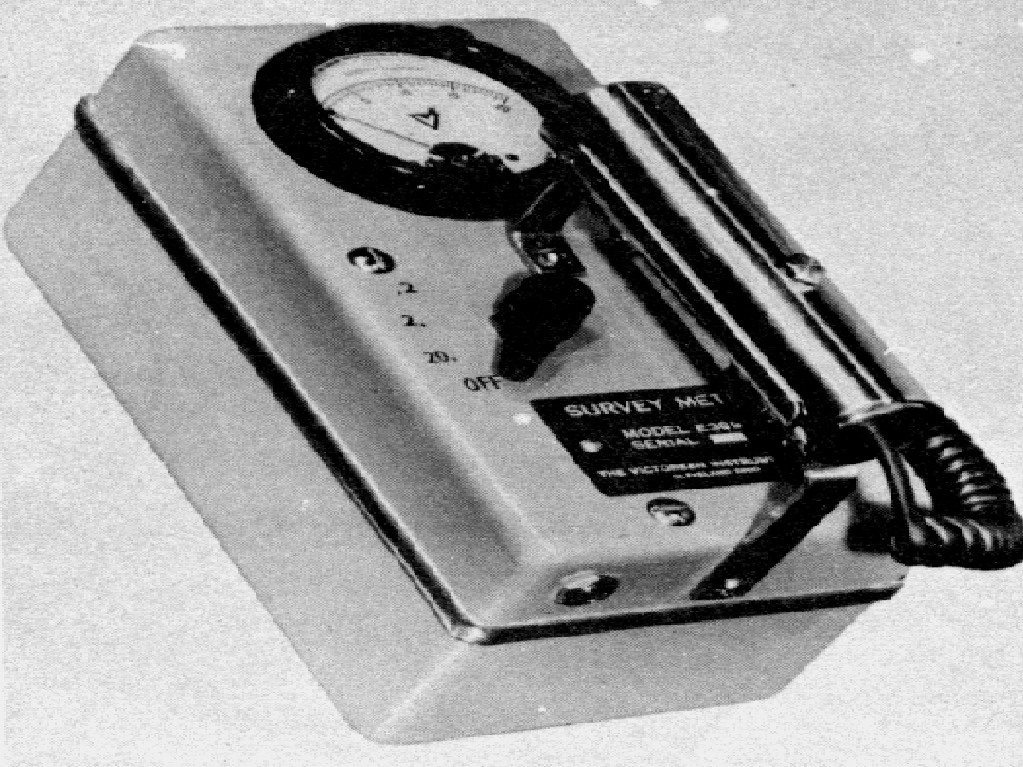
Victoreen Model 389 Thyac 1950
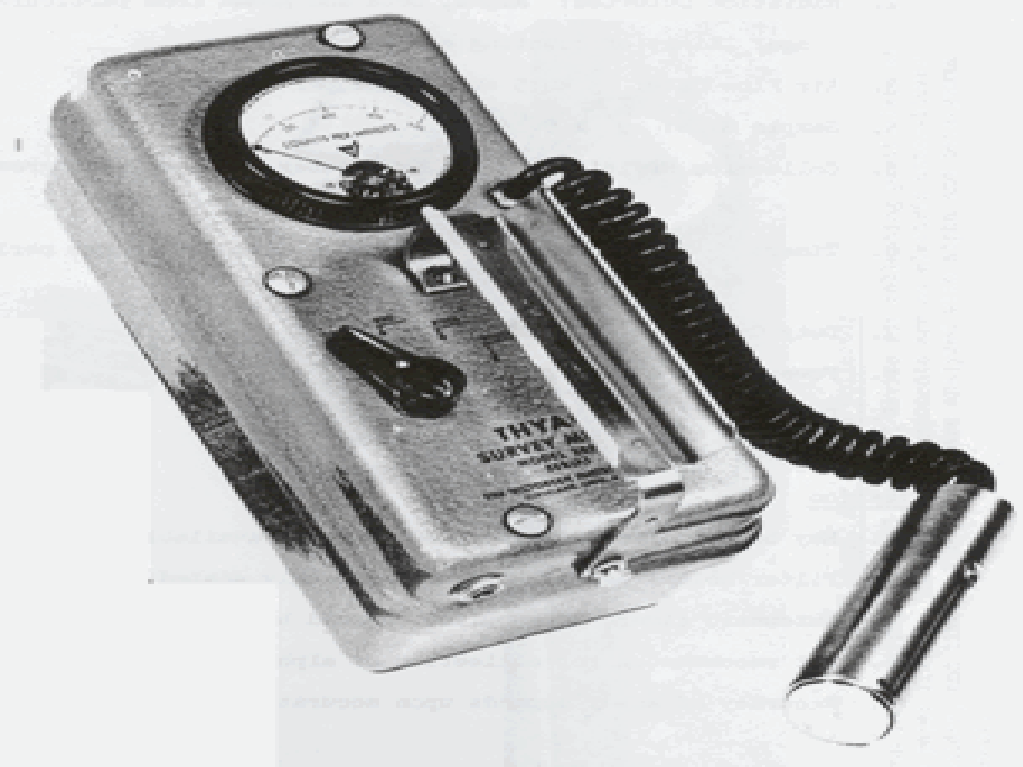
Victoreen Model 389 Thyac
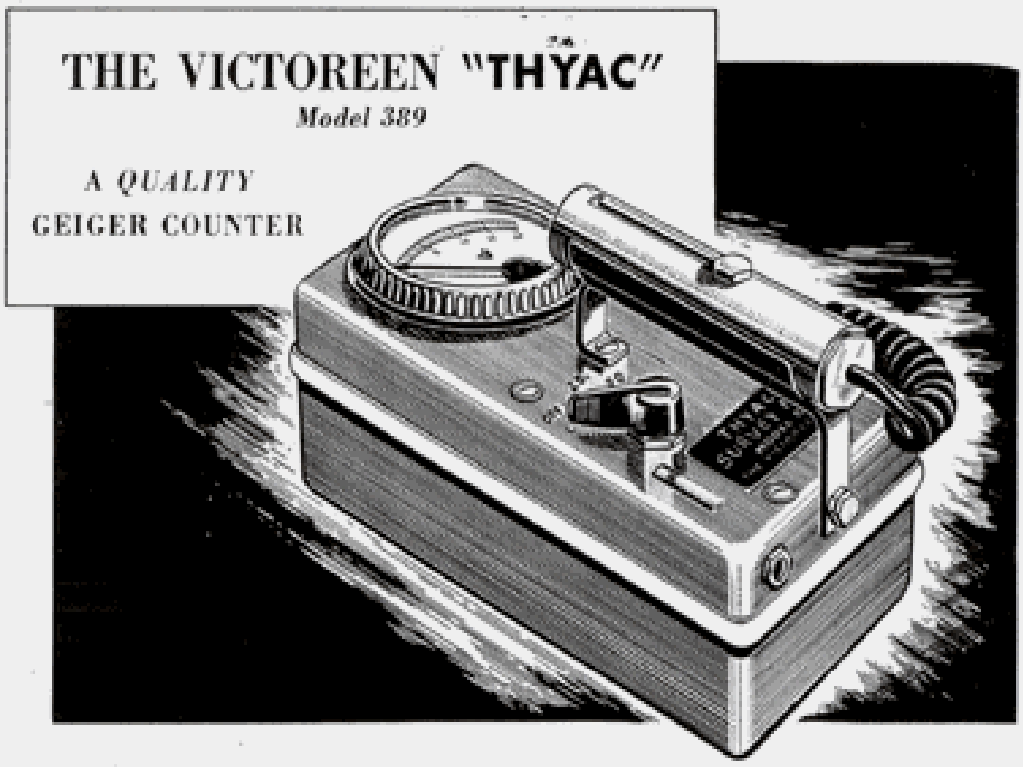
Victoreen Thyac Model 389 Ad 1952
The Thyac Model 389A was a GM counter for beta and gamma offered in 1950. According to the Thyac 389/389A manual, it was similar to the Model 389 except that it had a neon glow tube pilot light on the control panel to indicate that the batteries are delivering the correct voltage and the unit is tropicalized to prevent fungus growth in tropical climates. This unit was used at the Los Alamos Scientific Laboratory in 1954.

Victoreen Thyac III Scintillation Counter
The Victoreen Thyac was introduced in 1950 as a survey meter for low intensity beta and gamma radiation. The case was make of fiberglass. This was the beginning of a series of Thyac instruments. It had a thin walled aluminum GM tube known as the Thyrode. It had three ranges from 800, 8000 and 80,000 cpm and 0.2, 2 and 20 mR/h. It weighed 5.5 lbs. It used one 1.5V and one 4.5V batteries.
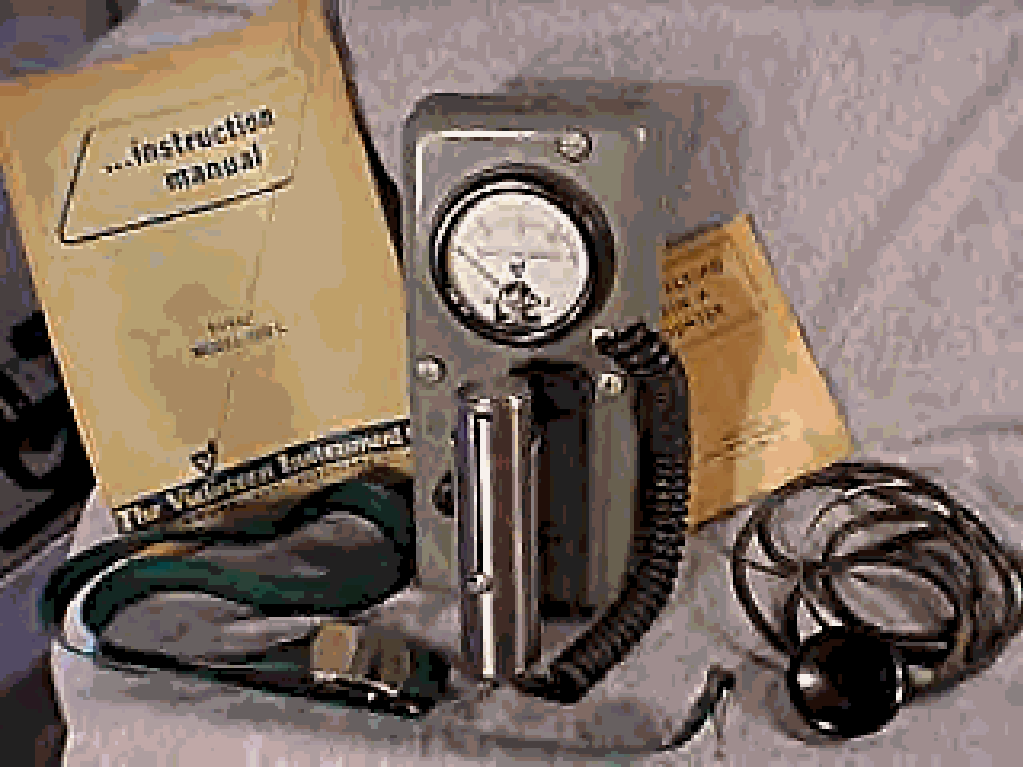
Victoreen Model 389 1953
The Thyac 389C was introduced in 1953. It was a geiger tube for monitoring low intensity beta and gamma radiation. The case was made of fiberglass-reinforced plastic making it tough and ready for rugged climates. The unit was 10" x 4-3/4" x 6-3/4" and weighed 5-7/8 lbs. including the probe. It had an on-off pilot light. It has one control knob for fingertip operation. It could standard beta window Geiger probes or bismuth lined counter tubes. Sensitivity was 800, 8000 and 80,000 cpm or 0.2, 2, and 20 mR/h. The weight was 5 lbs. and could operate for 110 hours per battery charge. The unit was similar in size and shape to the original Model 389. The unit sold for $225 in 1953. The unit was still for sale in 1955 for $225. In 1957, the Los Alamos Laboratory modified the Thyac to use their own alpha scintillation probe consisting of a zinc sulfide phosphor.
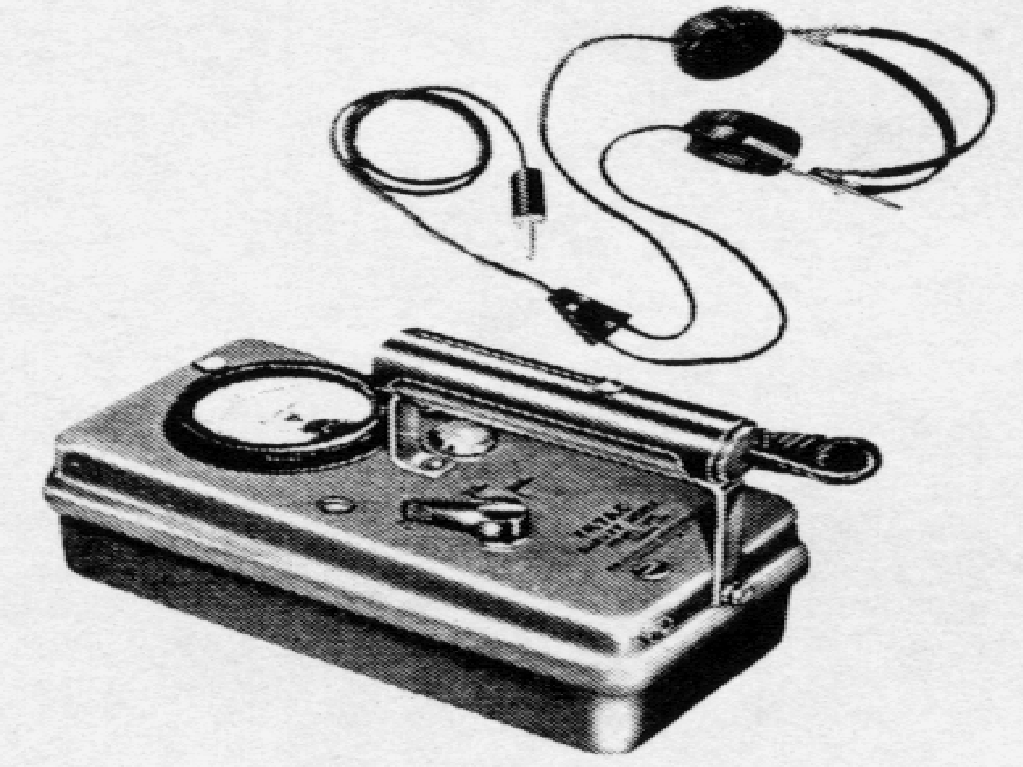
Victoreen Thyac 389C 1953
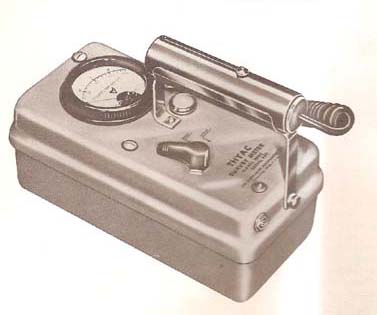
Victoreen Model 389C 1955
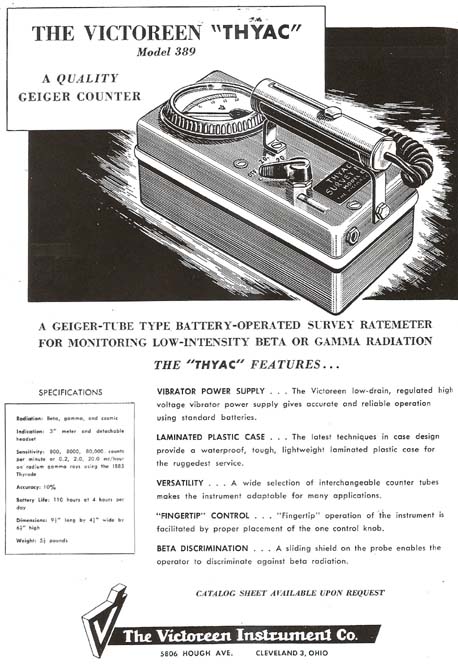
Victoreen Model 389C Thyac Ad 1952
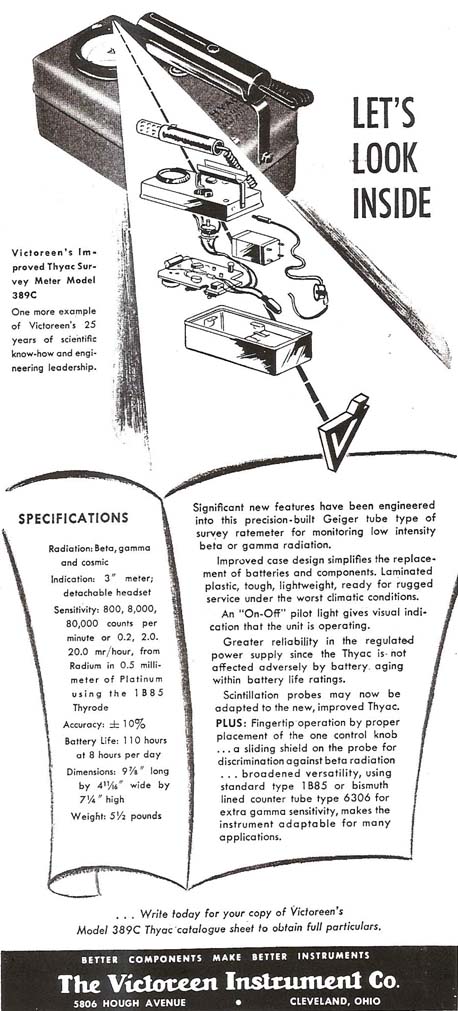
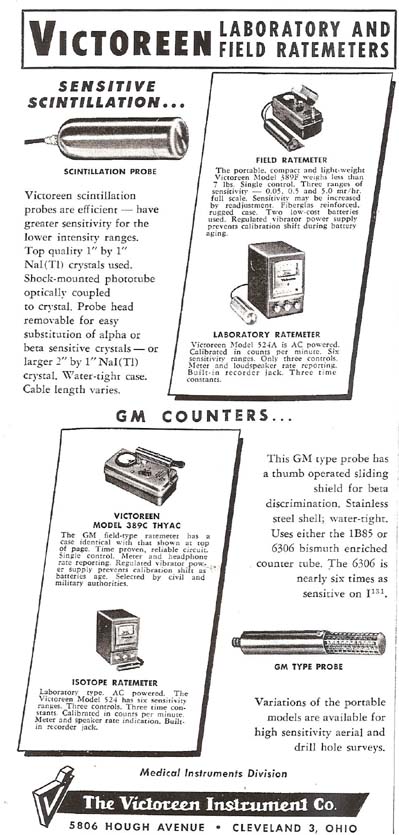
Victoreen Model 389C Thyac 1953 (left) and 1954 (right)
The Model 389-F is a compact, portable and lightweight field scintillator introduced in 1953. It has a single control and three ranges of 0.5, 5 and 50 mR/h. It can also be obtained with a scale of 800, 8,000 and 80,000 cpm. It has a fiberglass reinforced, rugged case. The probe is 2” diameter by 8.5” long and contains a phototube and 1” x 3/4” NaI crystal and metal shield. The probe has a 4’ cable. It uses one 4.5 and one 1.5 volt batteries. An alpha detector head is also available. The unit was 8.5” x 10” x 4.75” and weighed 7.5 lbs.
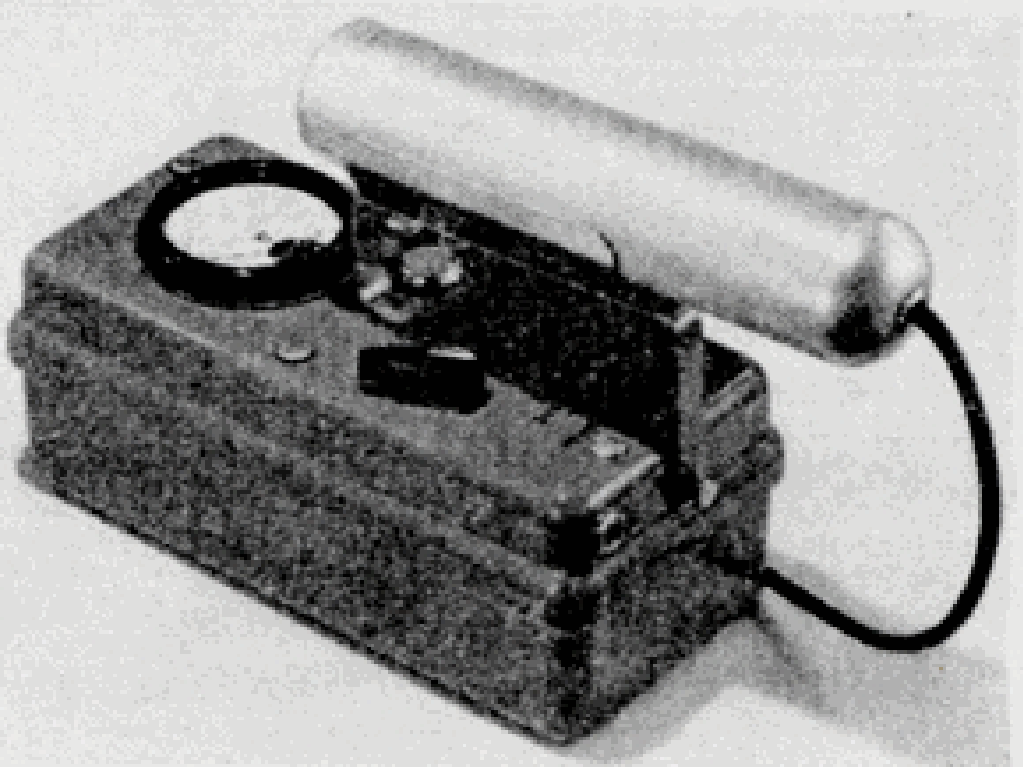
Victoreen Thyac Model 389-F 1953
The Victoreen Model 389H Super Scintillac Counter was offered in 1955. It was designed for the professional prospector with high sensitivity for ground, air and drill hole exploration. It has a long cable so the probe can be suspended from an airplane or in drill holes. It has 6 sensitivity ranges 0.025, 0.05, 0.25, 0.5, 2.5 and 5 mR/h. The case was 10: x 4-3/4" x 8-1/4" and weighed 8.5 lbs. The probe was 2" dia x 12" long. IN 1955, the unit sold for $715 with the standard NaI detector or for $1140 with a 2" x 2" NaI. A 50' cable could be purchased for $35.
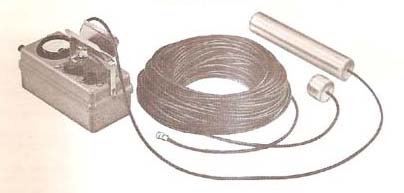
Victoreen Model 389H Super Scintillac 1955
The Victoreen Thyac III 389C was originally designed for the US military. It sold for $225 in 1955. It comes in a rugged case, and weighs 5.5 lbs including probe. The case is fiberglass reinforced plastic and measures 10” x 4.75” x 6.75”. The GM is located in the probe with a four foot cable. It also has a beta shield. The meter ranges from 0.2, 2.0 and 20 mR/h. It operated from one 1.3 volt mercury cell and one 4.5 volt battery. It is voltage regulated maintains calibration as the battery ages. It comes with a carrying strap, batteries, and earphone.
The Victoreen Thyac II Model 646 was an improved version of the Model 389C Thyac and sold for $255 in 1955. The probe housed the geiger counter with a slide to expose the window for beta counting. The case was 10" x 4-3/4" 6-3/4" and weighs 5-7/8 lbs. It featured a six-range sensitivity from 500, 1000, 5000, 10,000, 50,000 and 100,000 counts per minute. The unit would read 0.2 mR/h at 800 counts. It also comes with four time constants from ½ to 10 seconds. It was designed for laboratory use or for uranium prospecting. It also had a deep well probe with a 100' cable (expandable up to 500') for $95.
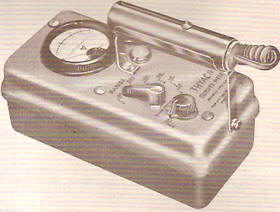
Victoreen Thyac II Model 646 1955
The Cutie Pie is a portable, battery operated, air ionization chamber for the detection of beta and gamma radiation. Measurement ranges are 50 mR/h to 5000 mR/h. The ionization chamber is 7.6 cm diameter by 14.4 cm long. The end window of the chamber is 6 mg/cm2 cellophane and the walls are 440 mg/cm2 phenolic. The end window has a removable beta shield.
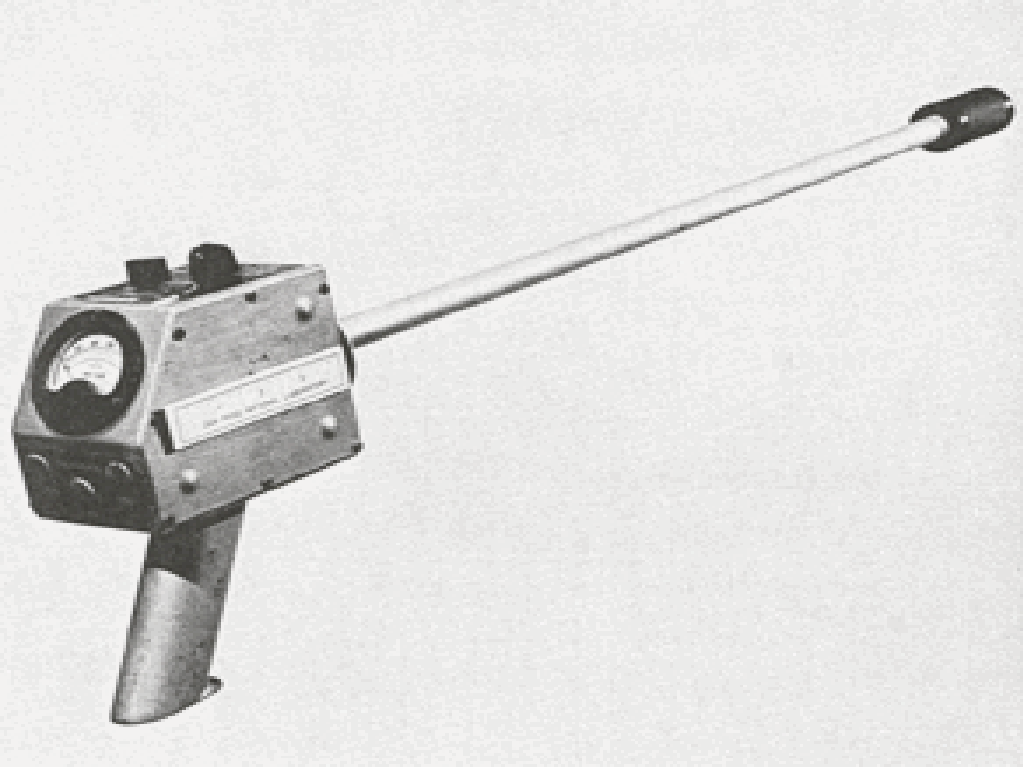
Victoreen Cutie Pie with Expansion
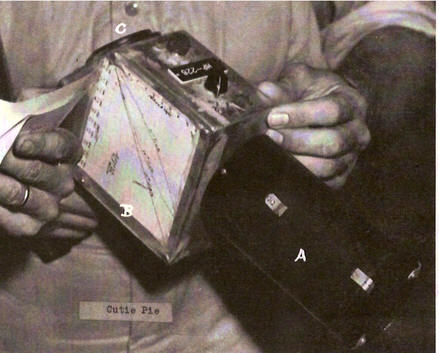
Victoreen Cutie Pie

Victoreen Cutie Pie High Range
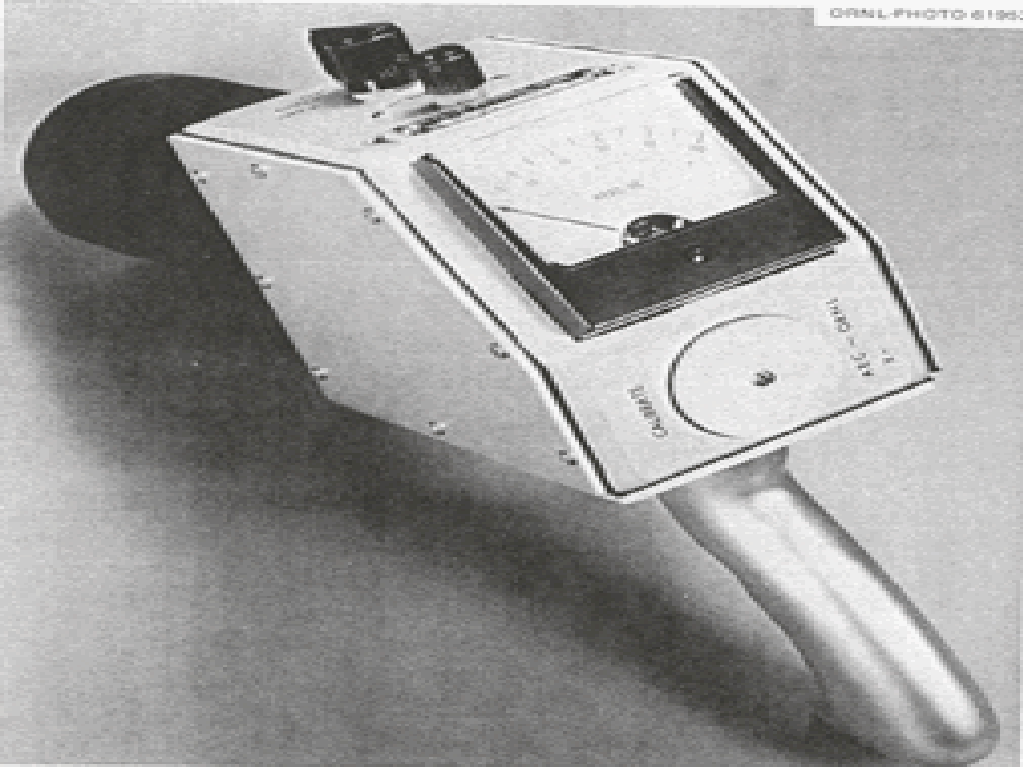
Victoreen Cutie Pie Oak Ridge
The Cutie Pie Model 740 was introduced in 1955. It was designed to detect alpha, beta and gamma radiation. It is battery operated and has three ranges from 100, 1000 and 10,000 mR/h. It was engineered to requirements of the Health Physics group at Oak Ridge National Laboratory. Measures x-ray and gammas from 40 keV to 2 MeV. It will measure alphas down to 2-3 MeV and 35 keV betas. The Model 740A has ranges from 50, 500, and 5000 mR/h and the Model 740B ranges from 25, 250, and 2500 mR/h.
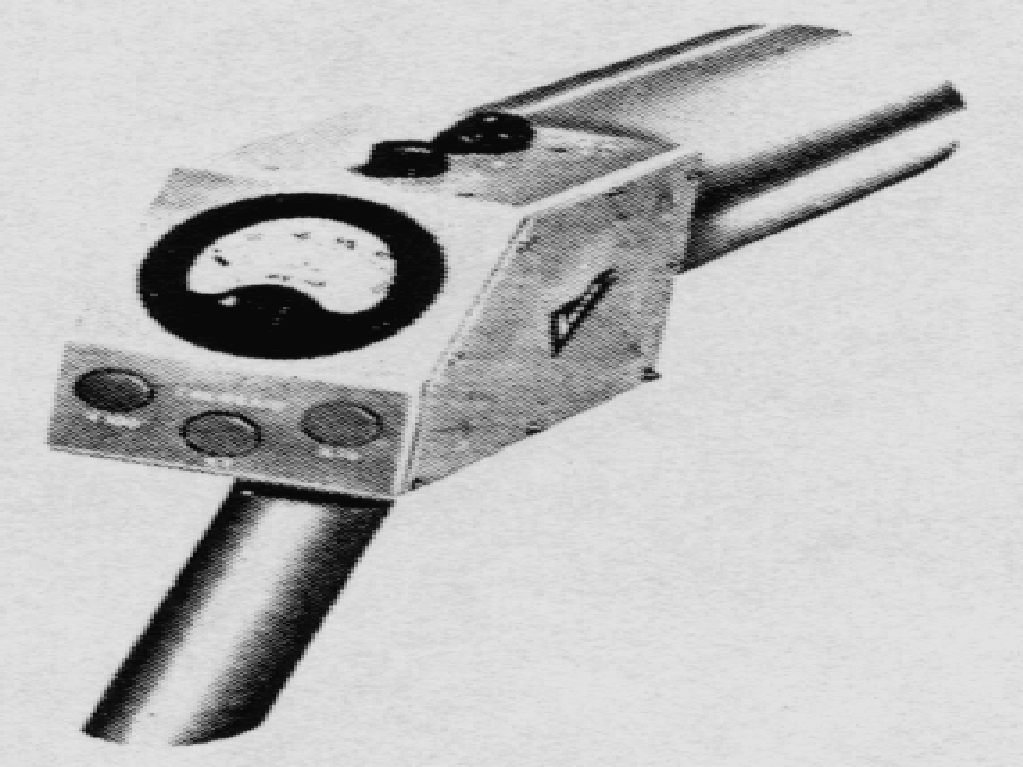
Victoreen Cutie Pie Model 740 1958

Victoreen Cutie Pie Model 740B
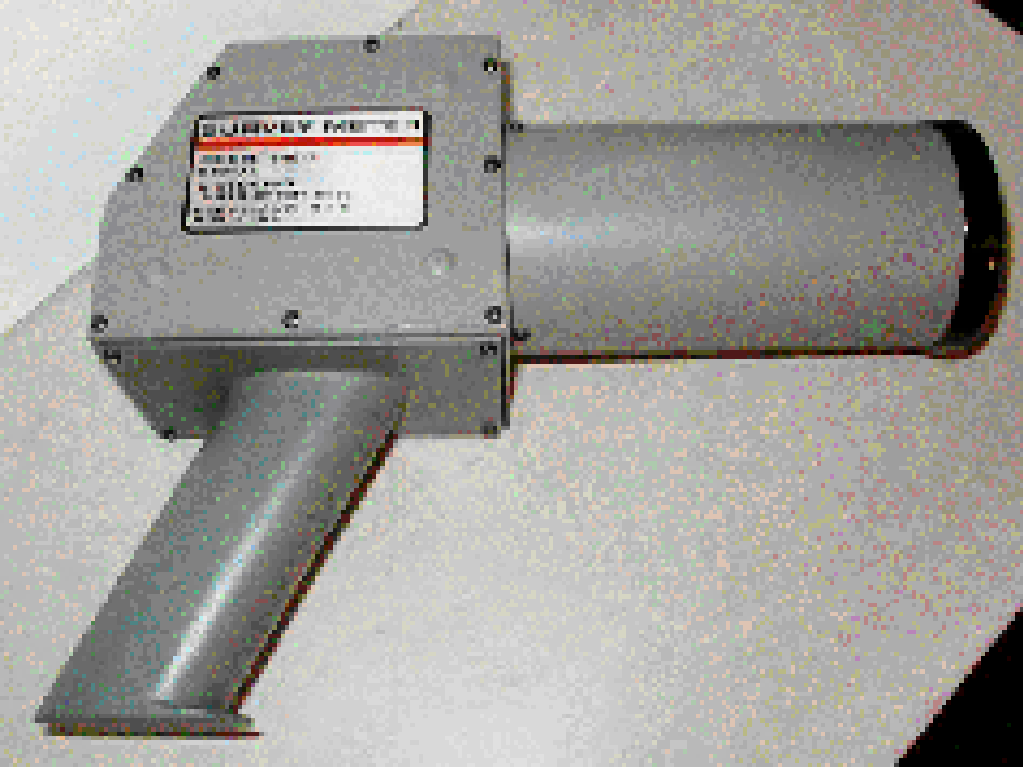
Victoreen Cutie Pie Model 740-F
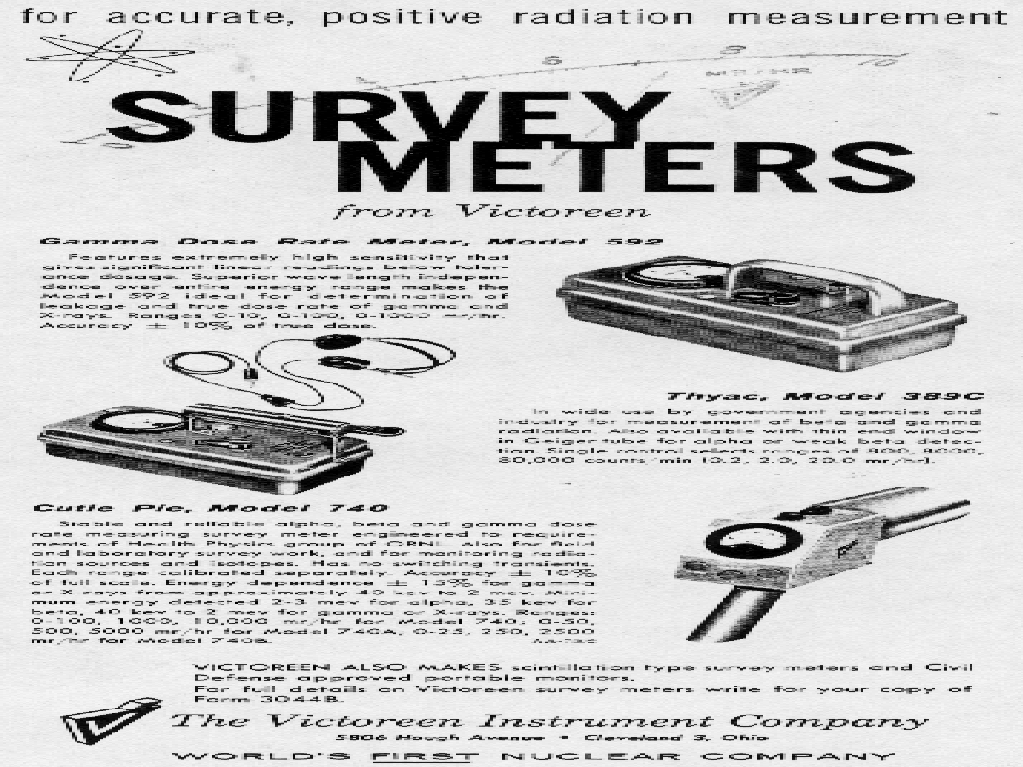
Victoreen Ad 1958
Victoreen Instruments for Uranium Prospecting Catalog 1955
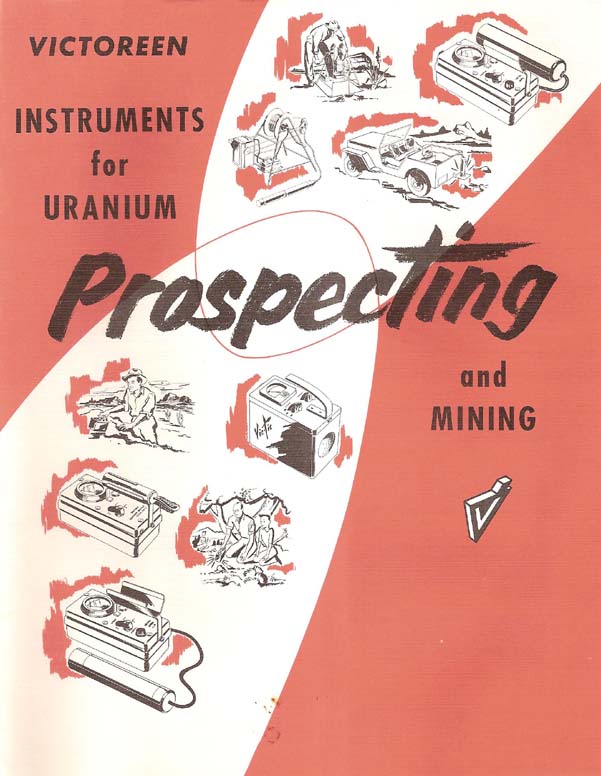
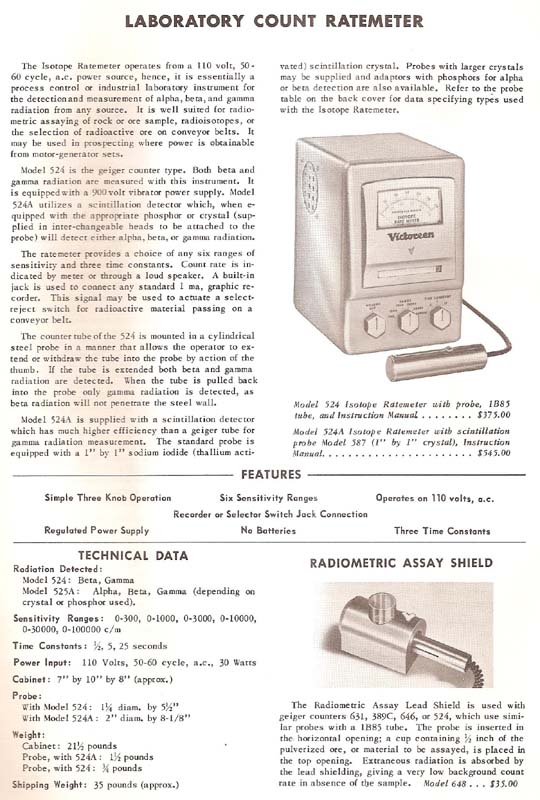
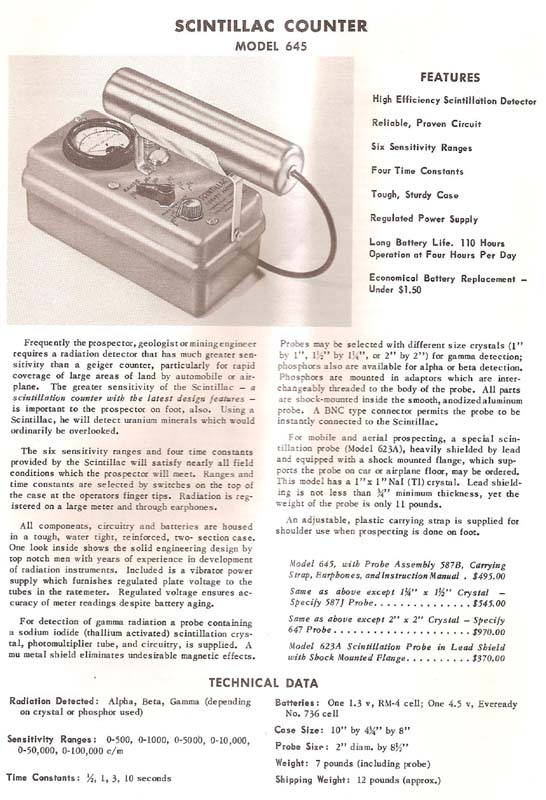
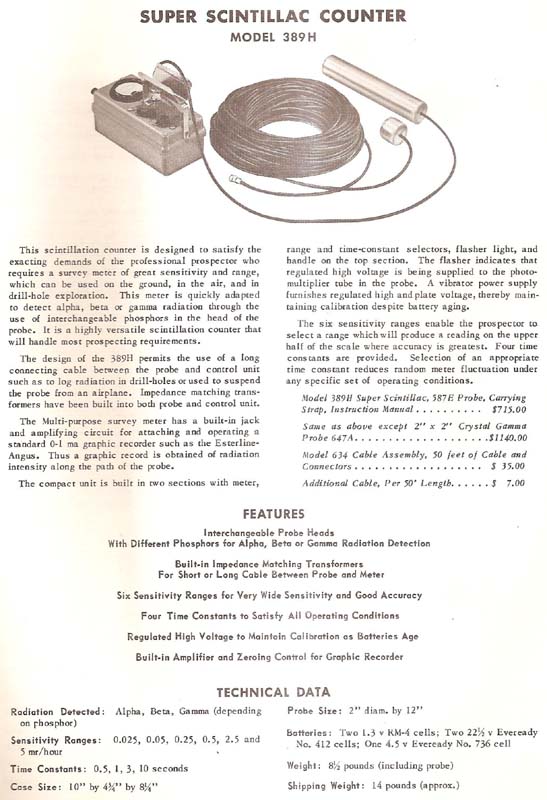
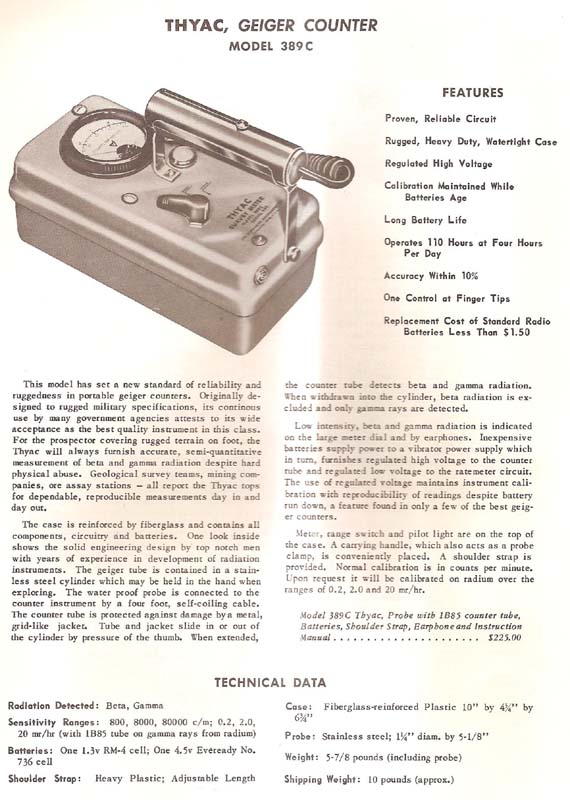
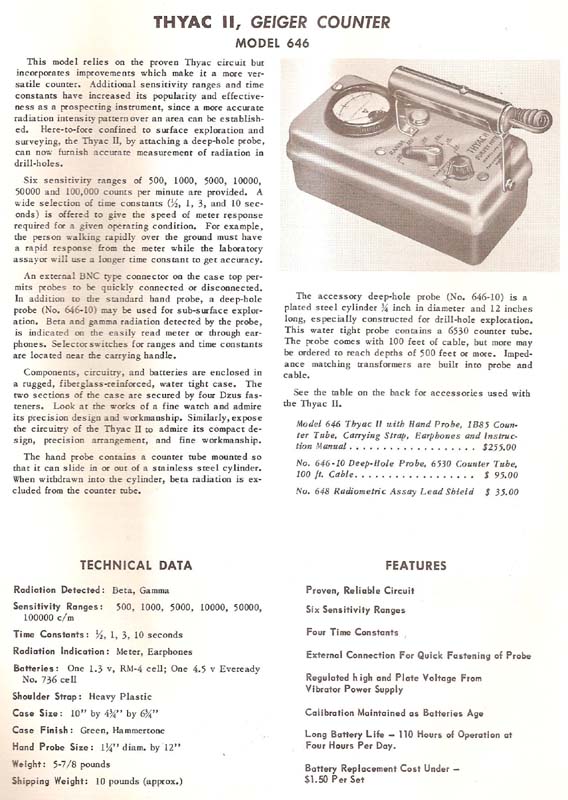
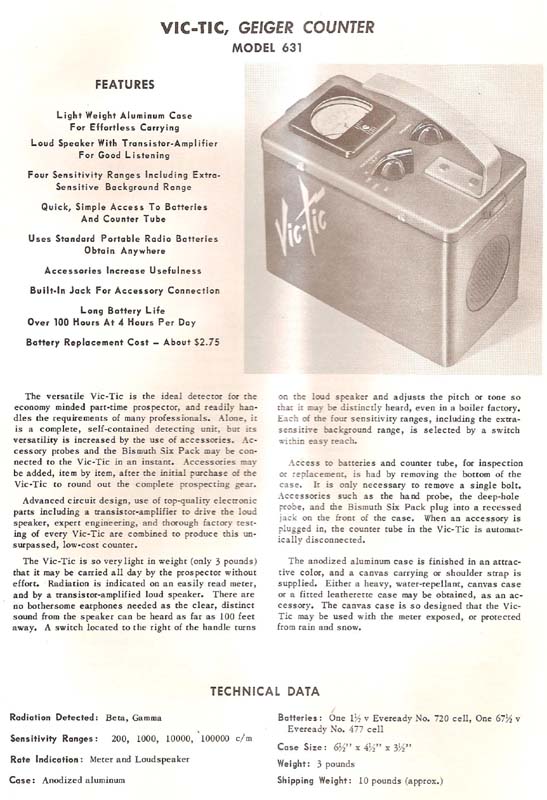
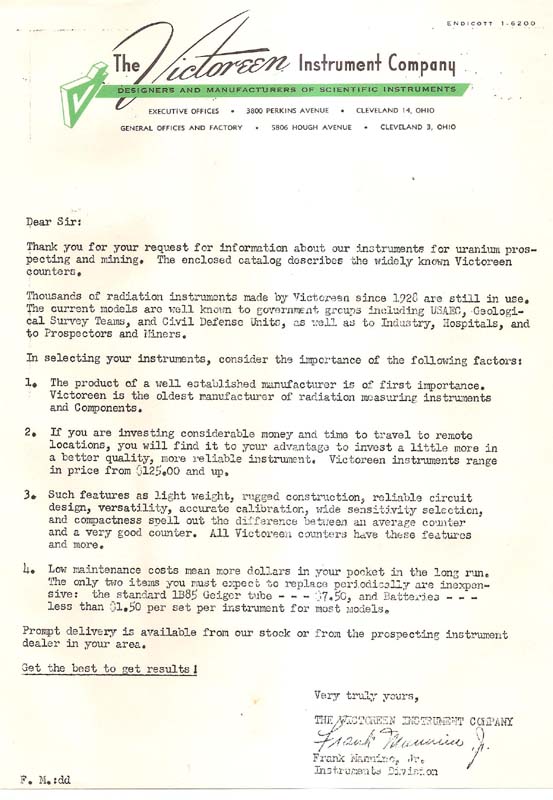
Victoreen Sales Letter 1955
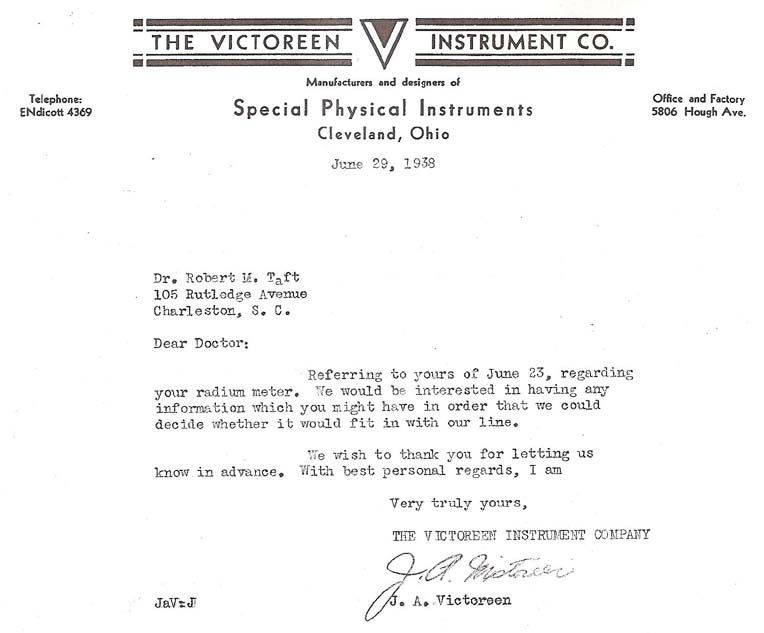
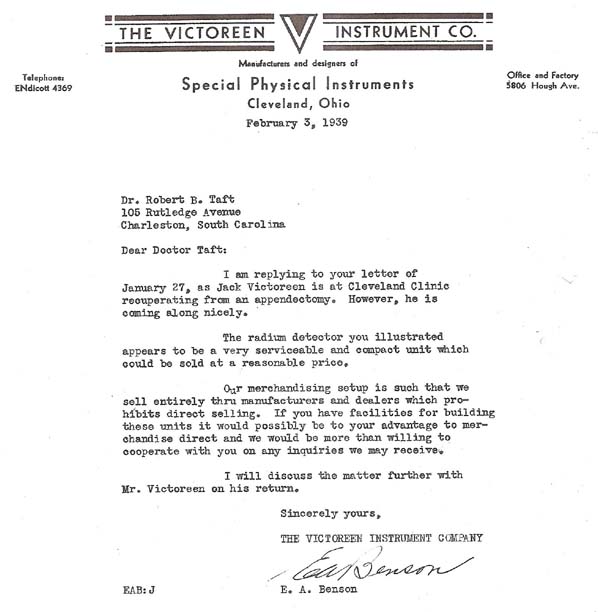
Letters from John Victoreen to Dr. Robert Taft "Radium Hound" 1938 (left) and 1939 (right)